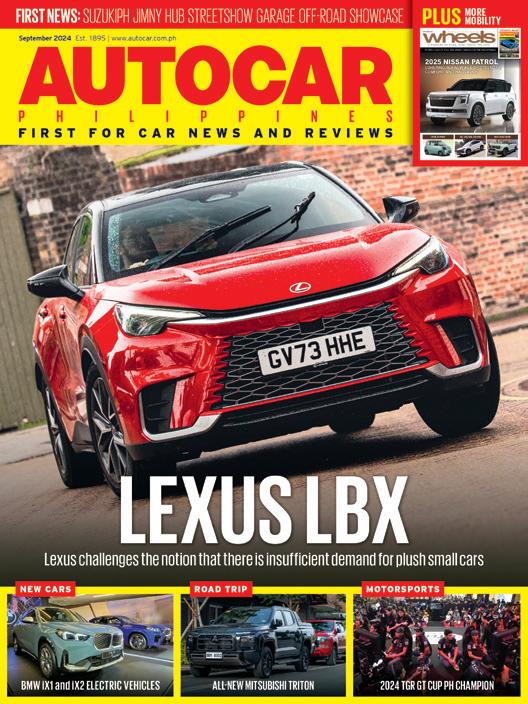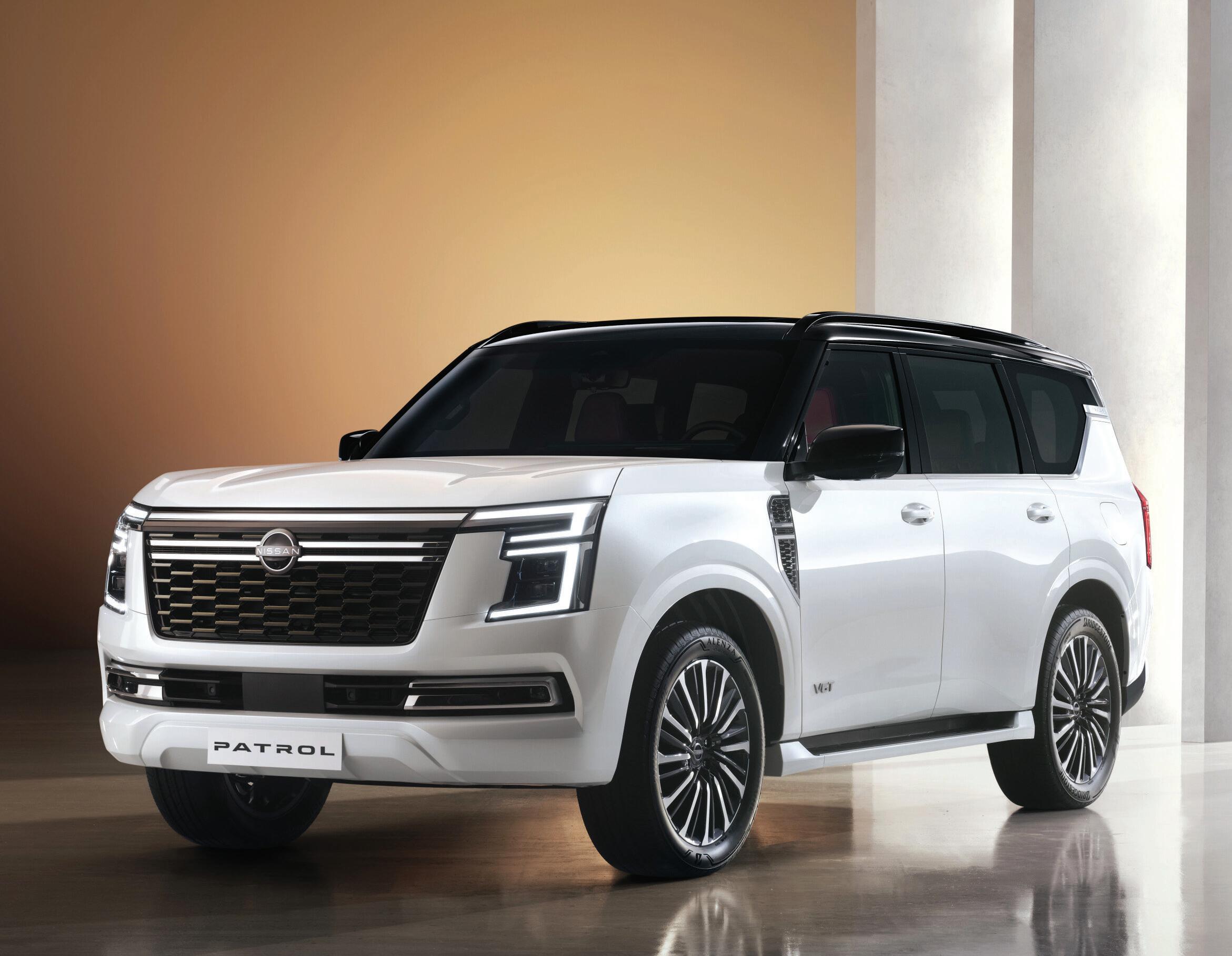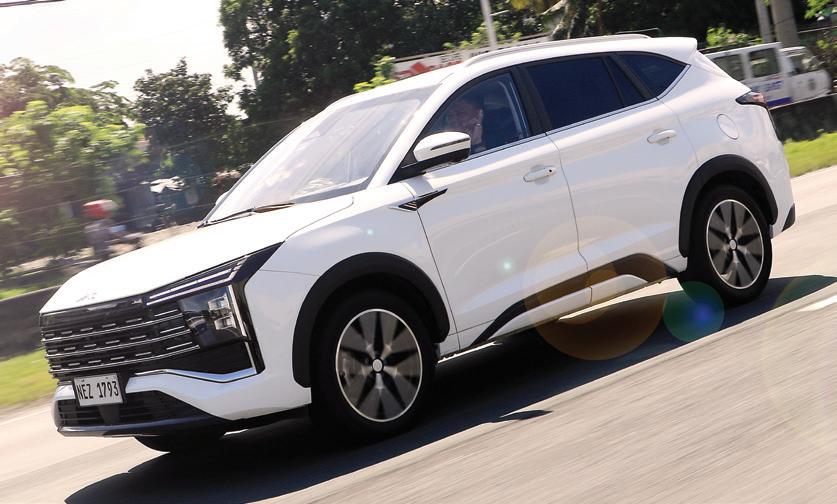


Lexus challenges the notion that there is insufficient demand for plush small cars

ROAD TRIP













Lexus challenges the notion that there is insufficient demand for plush small cars

ROAD TRIP










The ‘Ber months are finally here and that means we’re in Q4 of this year already and the Christmas season is around the corner. The auto industry is still chugging forward, promising more as we approach year end.
We’ve been pretty busy this month as usual, but we’ve cooked up something exciting for you coming out next month called “Trip lang!”, we’ve done a series of fun road trips and made couple of videos about them. Follow our facebook account facebook.com/autocarphilippines so you’ll know when they come out.
In this issue, we have as usual, industry news, motorsports and in Fresh off the Boat, the latest offerings that just came into the market, and this month we’ve got the JAC JS8 Pro 7 seat suv, the sporty GAC Emzoom Touring and BMW’s latest electric offerings, the iX1 compact SAV (Sports Activity Vehicle) and the iX2 SAC (Sports Activity Coupe).
On Road Trip, we join Mitsubishi’s All-New Triton media drive to Bataan, we get the chance to experience it on long country roads and take it off pavement. Our cover story is the Lexus little hybrid suv, the LBX. It might be small but it is loaded with a lot of big features.
We’ll leave it at that for the moment, as we’re already working on the next one… as always, there’s more to come and to make sure that you’re always informed, bookmark www.autocar.com.ph


WD differentials control the basic function of converting the power and rotation of the main driveshaft, to the front wheels. Differentials control how much the driver or passenger tire wheels are moving at any given point, as they are not always at the same speed. During a turn, the inside wheel turns less than the outside wheel, and the differential controls this.
Differential Drop Kits, a more often over-magnified modification, are simply designed to lower your differential housing to help correct the angle at the constant velocity joints on your axles. Increasing lift height, makes your CV axles sit at a bulkier angle and when dropping the differential they sit closer to level-off your new taller lift height. A satisfying thought, but more often not necessary.
Constant Velocity (CV) joints maintain similar strength when used within its ideal operating range. So as long as your CVs do not see angles beyond what they were designed for, the change in angle simply from the lift height alone will not cause any premature wear or failure to the joint itself. Depending how far you let that suspension extend, be smart on what parts you buy, this may never be a concern.
Major reputable suspension manufacturers guarantee that their ride height adjustable coil-overs and struts for most applications do not cause CV bind, by simply making sure they are the right length. The overall extended length of your coil-over or strut determines how far your suspension and, therefore, your axles are being extended. This means as long as they are not too long overall, CV bind is never a concern. If buying a good set of coil-overs and installing them and following the recommended guidelines, a differential drop kit may be a waste of time and money.
When would you need a differential

drop? Common cause is strut spacer lifts. The combined overall length of a larger lift spacer and even the factory struts is enough to allow the suspension to extend into CV binding domain. You may be able to go 3” of lift on a set of coil-overs without needing to move the differential, using a spacer kit with the same lift height might be causing binding already, all because of the additional overall length.
When adjusting ride height on a set of coil-overs, the total extended length is the same, you are just moving where it sits in its travel at ride height.
If going for articulation, you may likely only need better dampers. Anyway, spacers may be better off left for your local parking lot. It may likely be that much of clearance you thought you gained from adding that spacer is lost from dropping your differential.
Differential drop kits include assortment of spacers and hardware to slide between your differential and the factory mounting brackets. Applications run a cross member just below the pinion of the differential and front drive shaft, so it is only possible to lower the front half of the case. This pushes the larger part of the
differential housing lower in the chassis and means you will need to space out and lower your front skid plate or remove it. Stolen clearance is unimaginable and detracting on an independent suspension rig.
The greatest strengths of an independent suspension vehicle is the impressive amount of center clearance you get between the tires at ride height. Contrary to the cross member on a solid axle, your lower control arms and differential mount is the highest point of the undercarriage of the front of your vehicle when your suspension is at rest or extended. And your weakness.
So the answer to whether you need to drop your differential or not for the lift you are planning on running may be more complicated. A ton of factors to how you set up the vehicle considerably matters, but there is one easy way to ensure you never need one. On most applications, as long as you are looking at a set of ride height adjustable struts or coil-overs built by a brand known for what they are doing, your CVs will never bind, and a differential drop will never be something you need or even consider.



MONDAY
Guess what? I’ve bought a Ford Ranger Raptor. Not any old Raptor, though: I now own the very same machine, coloured Code Orange and with 13,000 miles on the clock, that has been in the benign ownership of fellow columnist and podjockey Mr Matthew Prior for the past few months as a long-term test car. In this very magazine he writes a poignant goodbye (it’s on p54), although for him it need not now be so final. He can borrow it any time. Some time ago I reckoned our household deserved a fourth car, something a bit off the wall. I fell in love with Raptors long ago and drove one a lot last Christmas. I love the shape and size, the indestructibility and the Fordness (I was practically born in the back of an Aussie Ford Falcon ute). Most of all I love the Raptor’s surprises: the yowl of the twin-turbocharged V6 on song, the smoothness of the 10-speed auto, the near-silent off-road tyres, the cruising refinement, the steering, the brakes, the damping. I have already had it a few weeks (magazine scheduling can run a bit behind reality) and am delighted. A few puzzled people don’t understand my choice, which has caused me to frame a new definition for true friends: they’re people who understand and accept whatever car decision you make.
TUESDAY
I spent the morning writing about the impressive Renault Scenic, driven for the first time on our roads and emerging with honour (see p31). However, for me the big feature of the car is a solitary button, coming soon to all Renaults. Scenics have no fewer than 30 forms of electronic driver protection (ADAS if you prefer) as standard, grouped under the Safety Shield title. EU law requires these gizmos – lane
❝ It’s that button I like. It’s going to start a revolution ❞
departure, speed limit bongs and all the rest –to start journeys in a working state. But Renault has come up with a single button that lets you configure all these systems as you want: you push it once as you start and get your preferred electronic recipe. As it happens, the Scenic’s systems are far less annoying than some, but it’s that button I like. It’s going to start a revolution.
A recent report on BEV progress from the House of Lords committee gets my attention and makes blindingly good sense. It exhorts government and industry to come up with a simple, uniformly understood battery health standard for used EVs. Apparently concern about battery condition deters used EV buyers and attacks the cars’ residual values. It need not be so.
While taking part in this year’s Distinguished Gentleman’s motorcycle ride to raise money for men’s charities, I called in at Bibury’s Classic Motor Hub. Saw this. Now convinced that two Ford utes shouldn’t be too many for an average Cotswolds household. But does the Steering Committee agree?


THURSDAY
As you’ve heard before, a lady in Japan called Kaoru translates this column for Japanese readers. She also does books and once did a fine tome on the life of Sir Alec Issigonis, the Mini pioneer, by Gillian Bardsley. Kaoru wrote to me last week, reacting to something I’d written earlier this year about the demise of the Brighton Speed Trials, often called the oldest motor race still running, staged first in 1905. From the Issigonis book, Kaoru gleaned that it was at the 1946 Brighton Speed Trials that Issigonis first met John Cooper, race car pioneer and the inspiration behind the fast Minis that have carried his name for 60 years.
Kaoru’s view – which I amplify here with all the energy I have – is that without the Brighton Speed Trials there may never have been a Mini Cooper. Given that BMW continues to make much hay from the Cooper name, and considering that the Brighton Speed Trials are ending only because its organisers need a few quid, surely it would behove the modern Mini company to make a contribution, revive a wonderful event and associate it for posterity with its brand. After all, Rolls-Royce is still proud of the first meeting between Charles Rolls and Henry Royce in a Manchester hotel.



EDITORIAL TEAM
IRA V. PANGANIBAN Editor-in-Chief
EDGAR QUESADA Associate Editor
NEIL PAGULAYAN Executive Editor
BINKY SIDDAYAO Technical Editor
OLSON CAMACHO Off Road Editor
MATT PRIOR | KRIS LIM | BINKY SIDDAYAO Columnists
JOHN REY SAN DIEGO Staff Writer
WILLIAM HERRERA | LUIS GERONA | RANDY PEREGRINO Contributors
ANJO PEREZ Senior Photographer
BONG BOADO | KEITH MARK DADOR | LOUIE CAMACHO
MARK QUESADA | ALAN RANCH SEVILLA | RANDOLPH DE LEON
ARNOLD RIODEQUE | BOBS JEROME | MEMERT MONTELOYOLA Photographers
RAYMUND RAVANERA Graphic Designer
ADVERTISING AND MARKETING SALES
DANG B. DORIA Sales And Marketing Manager
CORPORATE TEAM
Chairman of the Board GEORGE APACIBLE
President IRA V. PANGANIBAN
Vice President RONALDO TRINIDAD
Secretary OLSON CAMACHO
Treasurer EDGAR QUESADA
Administrative Head KAITE S. BELGICA
The original
car magazine,
published since 1895 ‘in the interests of the mechanically propelled road carriage’
International Director Alastair Lewis alastair.lewis@haymarket.com
Syndication Enquiries Isla Friend
isla.friend@haymarket.com
Editor Matt Burt
Editorial Director, Automotive Jim Holder
Managing Editor Allan Muir
Reviews Editor Will Nightingale
Chief tester Matt Saunders
New Cars Editor Rory White
Managing Director David Prasher
Chief Operating Officer Brian Freeman
Chief Executive Kevin Costello
Chairman Rupert Heseltine
Autocar magazine and the Autocar logo are trademarks of Haymarket Media Group Limited, United Kingdom and used under license by Autobrands Media Ventures, Inc. Content reproduced from Autocar magazine © Haymarket Media Group Limited 2011 all rights reserved.

The views and opinions expressed within Autocar PH magazine are not necessarily those of Haymarket Media Group Limited or those of its contributors.
Autocar magazine is published in China, Greece, India, Indonesia, Malaysia, Philippines, Poland, Singapore, Thailand, and United Kingdom.
www.haymarket.com

Editor-in-Chief – Anjo Perez
Contributors – Rica Sison, Joseph Bautista, Lara Camacho
William Herrera, Neil Pagulayan
Photographer – Mark Quesada
Staff Writer – John Rey San Diego
Graphic Designer – Raymund Ravanera
Contact us at info@wheelsph.com
Wheels Magazine is published monthly, a registered trademark of Asian Media Ventures, Inc. in cooperation with Gulf News. Copyright 2015.
In Memoriam
Alan Ranch Sevilla • Earl Manalansan • Dino Ray Directo III
All rights reserved. Printed in the Philippines. Reproduction in whole or in part without permission of Autobrands Media Ventures, Inc. is prohibited. For booking or inquiries on advertising, please call our advertising department at (02) 815-6519. For interested magazine distributors or magazine subscription please call (02) 815-6519 and look for Manel Catindig.
The views and opinions expressed within Autocar Magazine are not necessarily those of Autobrands Media Ventures, Inc. or those of its contributors. While every care has been taken in the preparation of this magazine, the publishers cannot be held responsible for the accuracy of the information herein, or any consequences arising from it. In case of all product reviews, judgements have been made in the context of the product based on Philippines prices at the time of review, which are subject to fluctuation and only applicable to the Philippines market.
Published by

Asian Media Ventures, Inc.
No.44 Gng. Aurora Quezon Ave BF Manresa, BF Homes, Parañaque City Telephone No. (02) 8-9259179

And just like that we are now in the Ber-months of 2024. With the Philippines being known for celebrating the Christmas season the longest, September marks the start of the most festive time of the year in the country. The local automotive welcomes the happiest time of the year with an interesting bunch of new model introductions.
JOHN REY SAN DIEGO
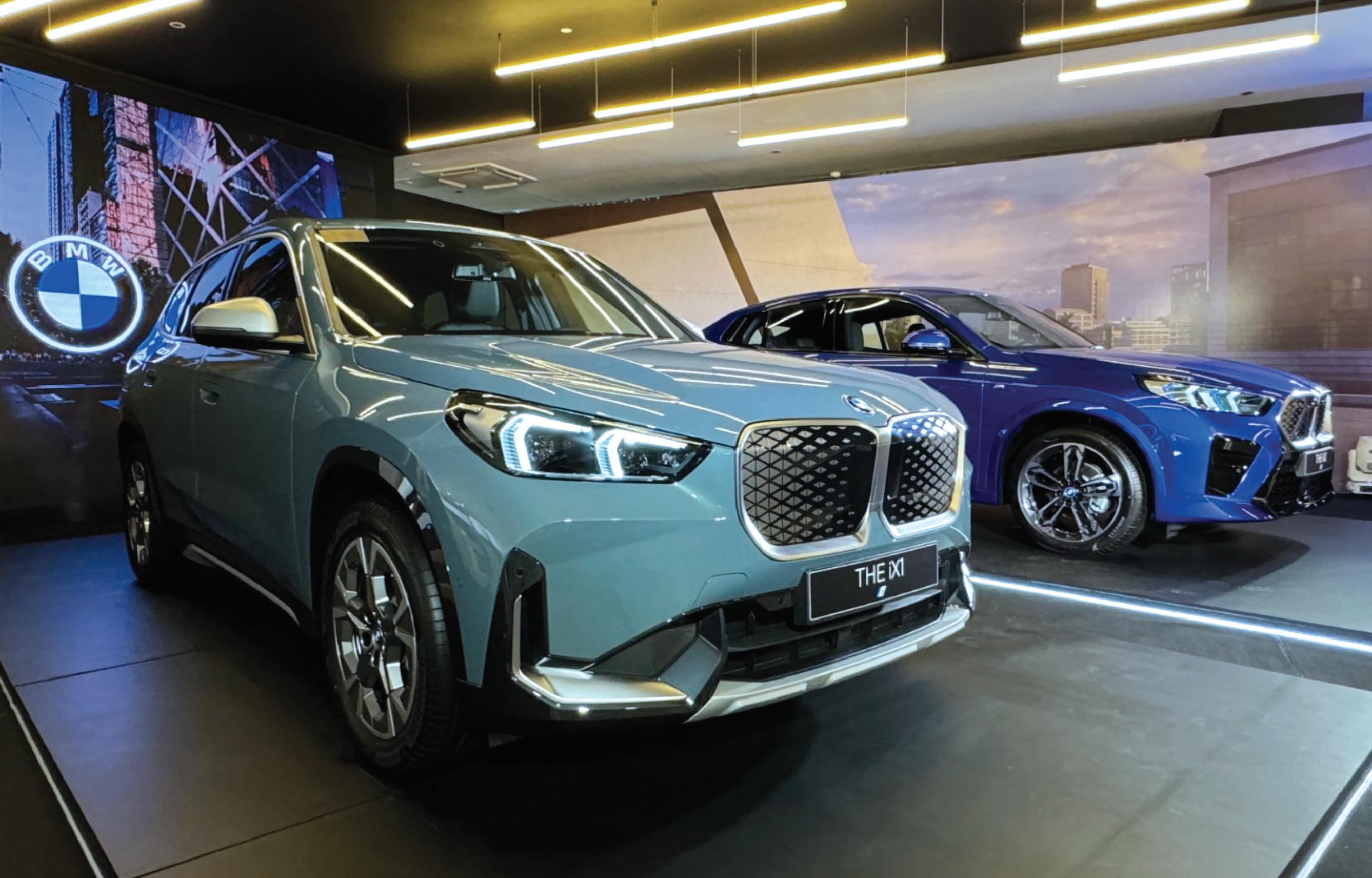
BMW Philippines, through its official local distributor SMC Asia Car Distributors Corp., strengthens its full electric model lineup with the addition of BMW iX1 eDrive20 xLine and BMW iX2 eDrive20 M Sport.
The BMW iX1 eDrive20 xLine is the marque’s first fully electric compact Sports Activity Vehicle (SAV) in the country. Under the hood, the iX1 eDrive20 xLine is powered by a single electric motor that
produces 204 horsepower and 247 Nm of torque, propelling the vehicle from 0 to 100 km/h in just 8.6 seconds. Despite its performance credentials, the iX1 maintains a focus on efficiency with a 64.8 kWh battery that delivers an impressive electric range of 430 to 473 kilometers on a single charge, depending on driving conditions. This range is complemented by an energy consumption
rating of 17.2-16.7 kWh per 100 kilometers, ensuring that drivers can enjoy the thrill of BMW’s driving experience for longer between charges.
The iX1’s exterior is inspired by modern reinterpretation of the signature BMW X design cue. Boasting bold and muscular proportions are the squared-off wheel arches, prominent kidney grill, sleek LED headlights and other distinctive X-shaped

design elements.
Meanwhile, the BMW iX2 eDrive20 M Sport heralds the arrival of the brand’s first all-electric Sports Activity Coupé (SAC) in the Philippine market. The iX2 eDrive20 M Sport shares the same robust 204 hp electric motor as the iX1, delivering 250 Nm of torque and a 0 to 100 km/h sprint time of
8.6 seconds. With a top speed of 170 km/h, this SAC is engineered to deliver a dynamic and responsive driving experience. The iX2’s 64.8 kWh battery provides a slightly longer range of 439 to 478 kilometers, depending on driving conditions, with an energy consumption rating of 16.9 to 15.3 kWh per 100 kilometers. This makes the
iX2 not only powerful but also remarkably efficient for its class.
Setting the iX2 apart from its BMW SAV counterpart is its M Sport package which highlights its design cues such as the Adaptive LED headlights, hexagonal grill, and flowing roofline which seamlessly blends into the rear.

GAC MOTOR Philippines proudly announces the launch of the Emzoom Touring, a new addition to the Emzoom lineup that enhances both style and performance. This latest variant introduces a sportier design, highlighted by the R-Style Body Kit, center-mounted dual exhaust pipes, and a distinctive Touring badge. The Emzoom Touring’s dynamic appearance closely mirrors the premium aesthetics of the top-tier R-Style variant, offering customers a visually striking option at an exceptional value.
Powering the Emzoom Touring is the familiar 1.5-liter TGDI engine mated to a 7-speed wet dual-clutch transmission

system. This combo delivers all 174 horsepower and 270 Nm of torque to the front wheels.
Inside, the Emzoom Touring features 10.25″ Multifunctional Touchscreen Display supporting Apple CarPlay and Android integration, leather seats, second-row air conditioning vents, and a rear USB port, ensuring comfort and convenience for all passengers.
Safety and technology are also at the forefront, with features such as Cruise Control, a Rear View Camera, Passive Entry Passive Start, a Tire Pressure Monitoring System (TPMS), Hill-Start Hold Control, Hill Descent
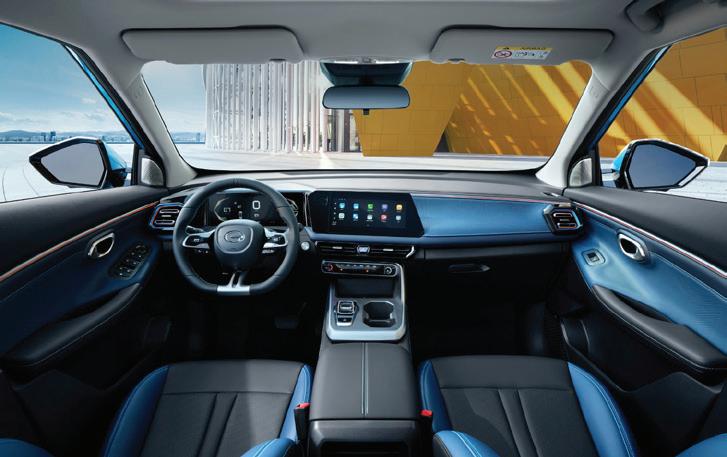
Control, and an Electronic Parking Brake with Auto-hold.
The special Emzoom variant is available in color options Graphene Grey, Moonlight Grey, Ivory White, and Superstar Silver.
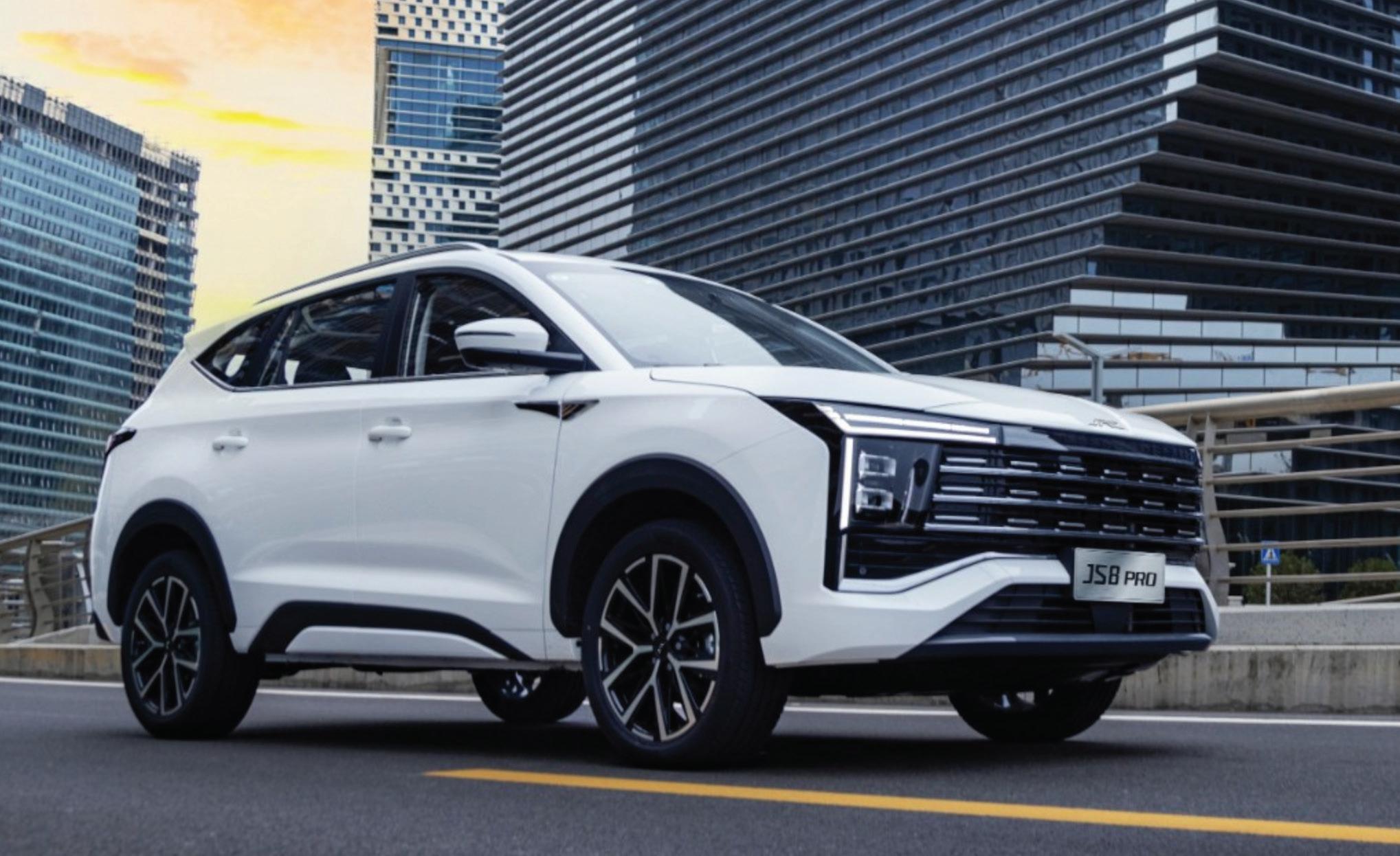
JAC Motors Philippines continues to expand its local offering with its latest introduction, the JAC JS8 PRO. The latest seven-seater SUV features a bold yet refined exterior highlighted by its automatic LED headlights and LED daytime running lights. Complementing its dynamic design are the upward-sloping window line, black fender trim, and striking two-tone 19-inch alloy wheels, all set against a generous 160 mm ground clearance that adds to its commanding presence on the road.
Inside, the All-New JAC JS8 PRO sets new standards in comfort and versatility. The cabin, trimmed in premium black leather, exudes luxury while offering ample space for seven passengers. A standard power panoramic sunroof bathes the interior in natural light, enhancing the airy ambiance and providing an open and inviting feel.
Dual 12.3-inch digital screens feature the JS8 PRO’s dashboard, one as a full LCD instrument gauge cluster and a
floating central touchscreen infotainment system. Its infotainment system supports Apple CarPlay and Android Auto connectivity, and also displays the 360-degree panoramic camera view, providing seamless access to navigation, media, and vehicle settings.
Powering the all-new JS8 PRO is a turbocharged 1.5-liter direct-injection inline-four engine that is rated to output 182 horsepower and 300 Nm of torque. These numbers are transferred to the wheels via a 7-speed dual-clutch transmission.

A state-of-the-art space commemorating the first anniversary of the partnership between BYD Cars Philippines and ACMobility

ACMobility, the country’s first end-to-end mobility solutions provider, and BYD Cars Philippines announced today the grand opening of the nation’s inaugural BYD Experience Hub.
The pioneering facility, set to redefine the BYD customer experience, will be operated by Iconic Dealership Inc., the retail arm of ACMobility.
As the brand continues to take charge of electrification in the Philippines, this new facility is a testament that offers Filipinos a unique and immersive experience that highlights the future of green transportation with BYD.
“To celebrate our first year with BYD Car Philippines, we mark this milestone by bringing the future of mobility closer to Filipinos through the BYD Experience Hub,” says Jaime Alfonso Zobel de Ayala, Chief Executive Officer, ACMobility.
“Every effort is a step closer to achieving our goal to build and sustain a better future for the next generation. As an innovative retail experience that demonstrates how sustainable mobility can uplift the
lives of our customers, the hub will not only showcase our cutting-edge vehicles and technology, but will also serve as a gateway to explore the opportunities that come with an electrified future,” Zobel continues.
Strategically located at Glorietta 1 in Makati City, the Experience Hub welcomes shoppers and passersby with its inviting ambiance and innovative design. It provides visitors with an engaging and interactive environment to learn about BYD’s advanced technology and the brand’s efforts to take the lead in a more electrified future.
The integrated space also showcases the growing EV lifestyle in the Philippines while creating a venue to access seamless transactions and innovative solutions.
“Filipinos are increasingly seeking more from electrified mobility, and together with ACMobility and BYD Cars Philippines, we’re delivering exactly that with the opening of our innovative BYD Experience Hub. This hub not only meets the evolving needs of Filipinos but also sets a new standard for the future of sustainable

transportation in the Philippines,” says Bob Palanca, Managing Director, BYD Cars Philippines.
Designed to be both welcoming and interactive, the BYD Experience Hub is more than just a showroom–it’s a high-tech center that invites visitors to take part in guided tours, witness live technology demonstrations, and connect with expert staff to gain a deeper understanding of electric vehicles.
Interactive displays are also present with each vehicle on display, showcasing important information, giving spec comparisons between BYD models, and highlighting unique key features of the cars. Visitors can even compare electric and internal combustion engine (ICE) vehicles at the hub, showcasing the benefits of going electric.
“The BYD Experience Hub is a novel way for us to reach out and
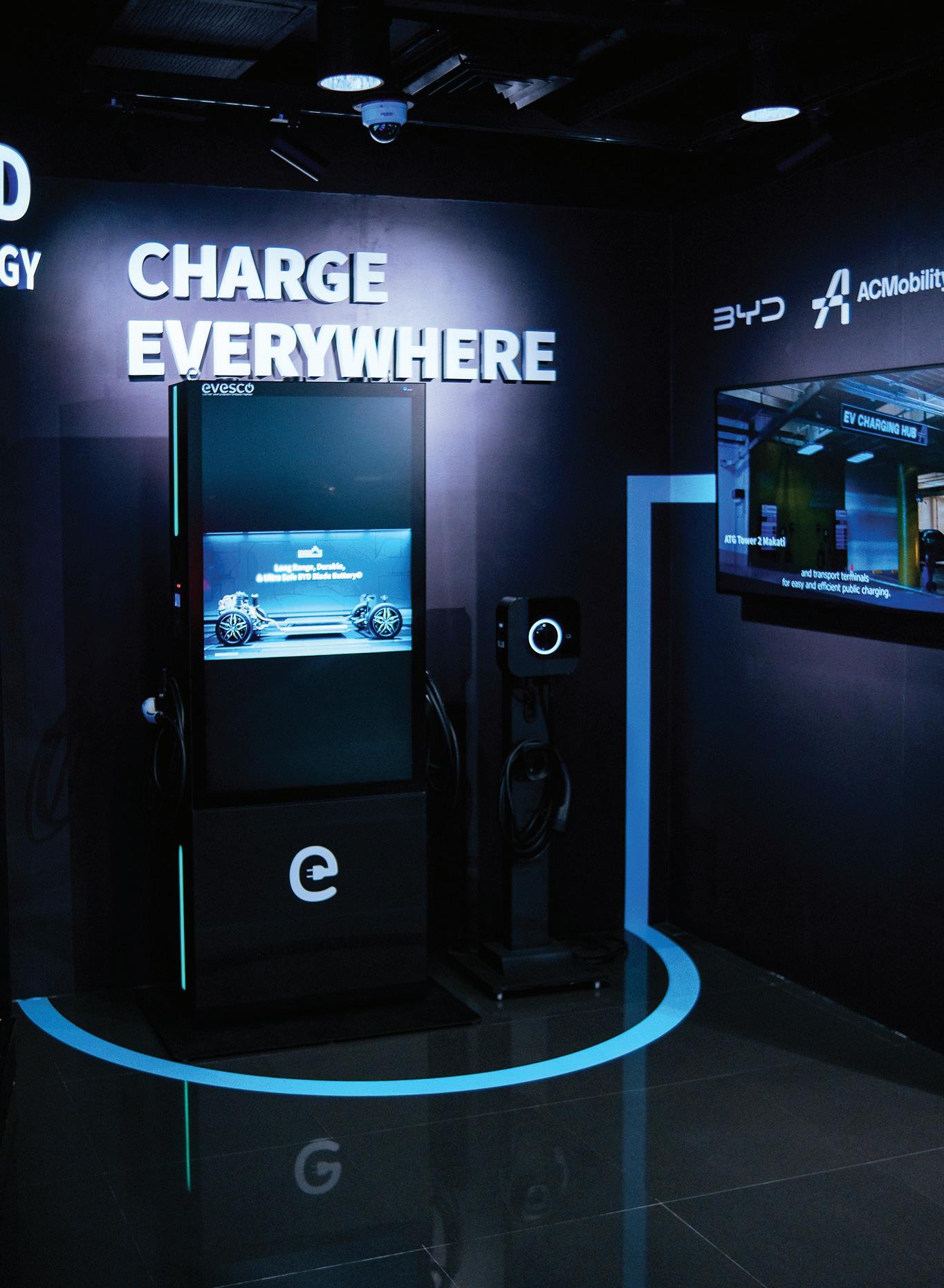
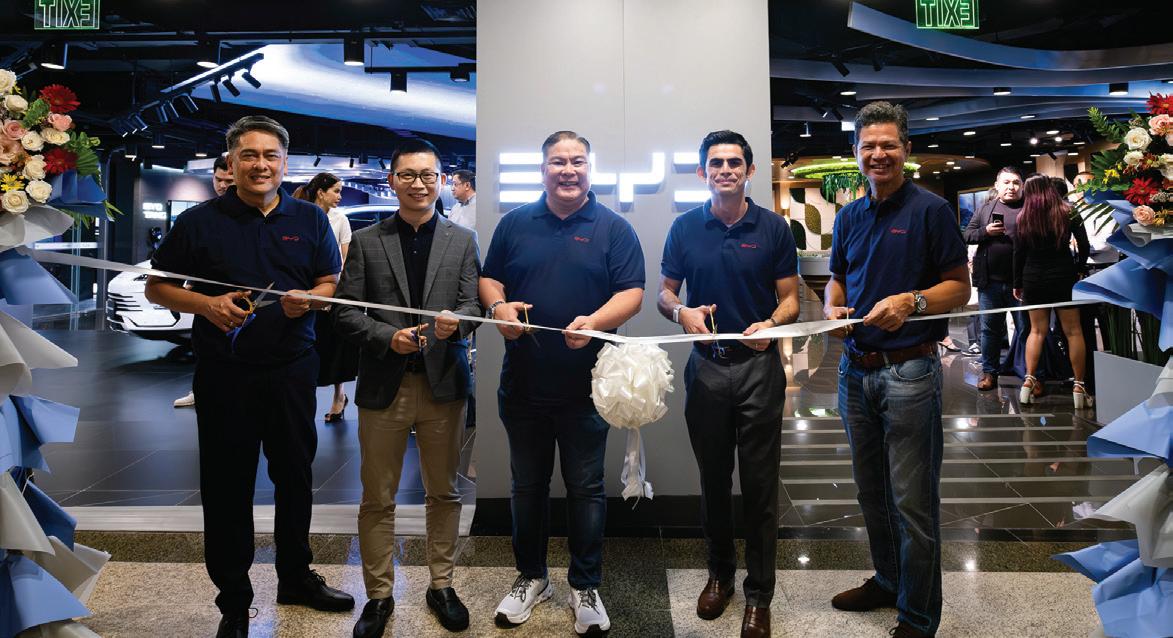
explain to more people the advantages and benefits of electric mobility,” shares Dennis Salvador, Chief Operating Officer of Iconic Dealership, Inc., the dealership arm of ACMobility.
“As the BYD brand grows, IDI is always on the lookout for more opportunities to connect with our customers. The BYD Experience Hub provides a differentiated automotive experience in that mall-goers can learn about BYD products and services, and even avail of test drives on the spot. This new center provides an interactive touchpoint for mall-goers to understand how electric vehicles and the BYD brand can support their evolving lifestyle,” adds Salvador.
At the heart of the Hub is the revolutionary Blade Battery, which is central to every BYD vehicle. Visitors can unveil the innovation that makes BYD unique to its competitors by learning about the battery’s efficiency, safety, durability, and performance.
As part of its promise to push for electrification, the brand focuses on the simplicity of charging an EV with an on-site charging

demonstration and information demonstrating the availability of the necessary infrastructure in the country.
For those interested in purchasing a vehicle, guests can speak with product experts and explore personalized offers tailored to their needs. Test drives and other experiential opportunities with the models are also available at the BYD Experience Hub.
As BYD Cars Philippines opens its doors to its new Experience Hub, it also celebrates its remarkable achievements through its first year of operations in partnership with ACMobility.
Since the start of 2024, the brand has made significant progress in solidifying its lead in the New Energy Vehicle (NEV) segment which comprises Battery Electric Vehicles (BEV) and Plug-in Hybrid Electric Vehicles (PHEV).
BYD is the number one NEV brand in the Philippines with a commanding market share of 70.5%. It is also the number one BEV brand with a 66% year-to-date market share.
The BYD Atto 3 is the brand’s top-selling NEV in the Philippines holding 35.1% of the NEV market. It is also the top-selling BEV model in the country at 44.1% of the BEV market.
Ranking second among NEVs is the recently launched BYD Sealion 6 DM-i at 18.3% year-to-date market share. While the BYD Dolphin ranks third in YTD NEV market share with 9.2% and the BYD Tang at fourth with a 6.6% share of the market for the first 8 months of the year.
The Top 4 New Energy Vehicles in the market from January until August this year are all BYD models reinforcing the growing trust of Filipino car buyers in the brand and its technologies.
BYD now also ranks second in combined industry sales of NEV and Hybrid Electric Vehicles (HEV) from January to August 2024 with an 11.7% share of the market.
Alongside these achievements, BYD Cars Philippines is also
expanding its dealership network and is on track to reach its goal of 25 dealerships by the end of 2024 with 8 more dealerships to be ready for opening in early 2025.
As BYD continues its electrified journey of innovation and sustainability, these accomplishments set the stage for the brand to solidify its presence in the Philippine automotive market and pave the way for future success.
The BYD experience hub is located at Glorietta 1, Makati City, open from 10 AM - 9 PM.



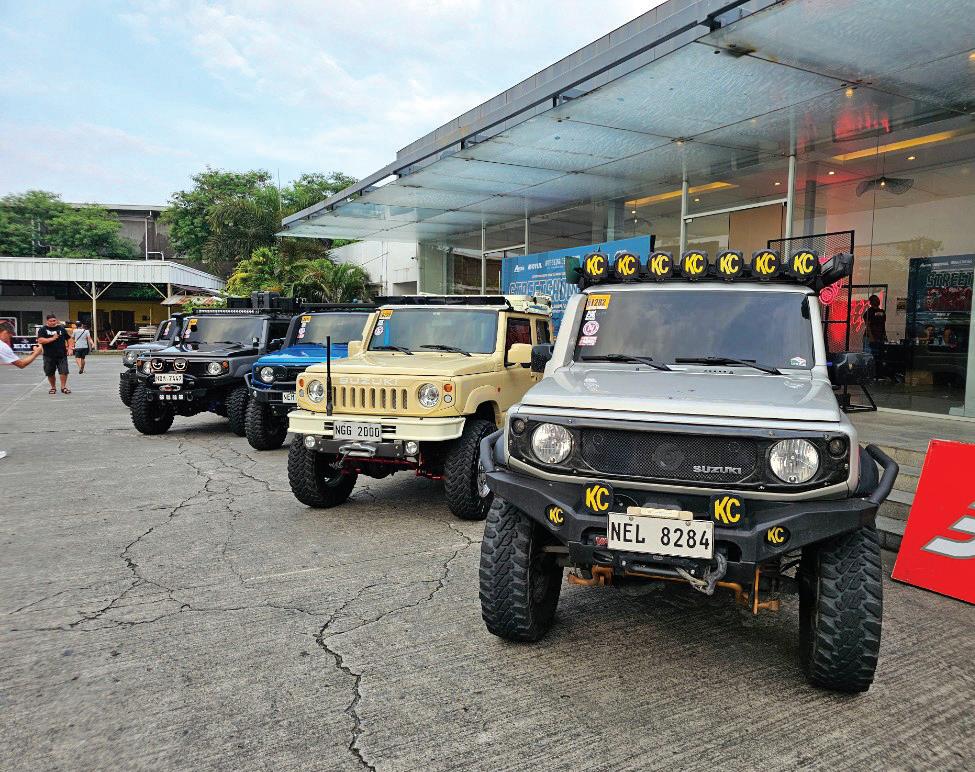


Jimny Hub, a dedicated subsidiary brand under Rugged Rigs that specializes in aftermarket products for the Suzuki Jimny, made a significant impression at the inaugural StreetShow Garage event, held on August 31, 2024, at the Metrotent Convention Center in Pasig City. At the event, Jimny Hub proudly showcased both 3-door and 5-door Suzuki Jimny models, fully equipped for off-road adventures.
Suzuki Philippines played a vital role as a copresenter of the first-ever StreetShow Garage event, underscoring its unwavering support and commitment to the Jimny community, owners, and enthusiasts. The event was graced by the presence of Mr. Norihide Takei, Director and General Manager for the Automobile Division of Suzuki Philippines, who delivered a speech recognizing Jimny Hub and all participants for their contributions to the successful staging of the event.
“I want to express our heartfelt thanks to Jimny
Hub for bringing together all the amazing companies that help make the Jimny experience so exciting for our customers. Your dedication and passion are what make events like this possible,” Mr. Takei said, emphasizing the collaborative spirit that defines the Jimny community.
Mr. Takei also took the opportunity to extend his gratitude to all Jimny customers for their continued support. He highlighted that this enduring customer loyalty drives Suzuki Philippines to strive to exceed expectations continually and “ensure that every Suzuki owner feels supported throughout their journey.”
The event featured an impressive lineup of customized Suzuki Jimny 3-door and 5-door vehicles, all outfitted with a range of off-road aftermarket kits and overlanding accessories. These vehicles demonstrated the Jimny’s true off-roading capabilities, showcasing how they can confidently tackle tough terrains and serve as the
ideal companion for camping adventures.
In line with their commitment to adventure and community, Jimny Hub announced its upcoming event, JimnyFest—the largest gathering of Jimny owners in the Philippines. Scheduled for February 2025 in Nueva Ecija, JimnyFest promises to be an exciting event for enthusiasts and owners. More details about the event will be shared in the coming months.
In addition to the
impressive displays, Suzuki Philippines provided eventgoers the unique opportunity to test drive the all-new Suzuki Jimny 5-Door. Two Jimny 5-door units were made available for test drives, allowing attendees to experience firsthand the rugged charm and off-road prowess of this legendary model. Representatives from Suzuki Philippines were also present throughout the event to address both sales and technical inquiries from potential customers.
For more information about the Suzuki Jimny or to explore the wide range of Suzuki vehicles, visit any authorized Suzuki Auto dealership nationwide or check out their website at http://suzuki.com.ph/ auto/. For daily updates on Suzuki, follow them on social media: like Suzuki Auto PH on Facebook at https://www.facebook. com/SuzukiAutoPH, follow them on X at https://x. com/suzukiautoph, and on Instagram at @ suzukiautoph.

MG Philippines makes another big splash with the opening of its latest flagship showroom along EDSA in Greenhills last August 20.
MG Greenhills, which touts the biggest service center for the British-born auto brand in the country, is another major step in strengthening the presence of MG in the Philippines and giving Filipino motorists access to highquality MG cars.
Motorists can now drop by MG Greenhills, a spacious 1,650-sqm. dealership that comfortably houses eight cars for customers to get a close-up look and feel of MG’s latest offerings, which include the MG G50 Plus, MG ONE, The New MG ZS, and more. Anyone who visits will be assisted
by MG Greenhills’ welltrained and passionate sales consultants, service advisors, and technicians who can provide quality and reliable service.
The Greenhills showroom also provides top-notch aftersales services, which include quick service, PMS, and general repairs at its 1,295-sqm. 14-bay service center. MG owners can be assured of prompt servicing when they come to MG Greenhills, and they can wait and relax in comfort at its luxurious lounge, which is fully equipped with a coffee bar.
“The opening of our new showroom at a prime location in EDSA and Greenhills signifies an important step in strengthening the presence
of MG in the Philippines,” said Felix Jiang, MG Philippines president.
“Filipino motorists have yet another place where they can experience for
themselves MG’s awesome offerings and potentially drive home the MG car that’s perfect for them and their lifestyle.”
MG Greenhills is located at 500 EDSA, Greenhills, San Juan, and is open from Monday to Saturday, 8:30am to 5:00pm. For inquiries and appointments, contact (0993-GRHILLS).

In a celebration of the special bond between humans and their pets,
JETOUR Auto Philippines Inc. (JAPI) held its inaugural “Furry Friends” Pet Day for Media on August 17, 2024, at Zig Café, located within the SM Aura Premier, McKinley Parkway in Taguig City.
The event welcomed members of the media along with their cherished pets for a day filled with bonding, pampering, and interactive activities designed for both animals and their owners. Zig Café provided a pet-friendly environment, offering a range of healthy treats and a welcoming atmosphere for all attendees and their furry companions.
The “Furry Friends” Pet

Day featured engaging interactive sessions with professional K9 trainers, who demonstrated basic training techniques, offered solutions for addressing common pet behavior issues, and shared insights into the vital role of K9 units in security and community service.
JAPI also highlighted that the event was held in
honor of International Dog Day, celebrated annually on August 26. Now in its 20th year, International Dog Day was established in 2004 by pet lifestyle expert and author Colleen Paige to raise awareness about the condition of animals and promote adoption, encouraging responsible pet ownership.
Reflecting on the deep,
affectionate connections between humans and their pets, JAPI drew parallels to the company’s own values.
Just as the bond between people and their pets is built on trust, loyalty, and care, JAPI’s relationship with its customers is founded on similar principles.
The “Furry Friends” Pet Day for Media was a tribute to these enduring
relationships, underscoring the joy and comfort pets bring to human lives and mirroring the confidence, convenience, and reliability offered by JETOUR vehicles.
JETOUR Auto Philippines Inc. is the official distributor of JETOUR vehicles and services in the country, offering a diverse lineup that includes the 7-seater JETOUR X70 Series (Journey, Travel, Sport) and the X70 Plus, the JETOUR Dashing and Dashing PHEV, the JETOUR Ice Cream Battery Electric Vehicle, and the 4X4 SUV JETOUR T2.
For more information about JETOUR and its offerings, please visit any authorized JETOUR dealership nationwide or log on to the official website https://jetourauto.ph/
The 9th Philippine International Motor Show (PIMS) officially kicked off its countdown with a press conference held on August 19, 2024, at the Grand Hyatt Manila in Bonifacio Global City. This year’s event, themed “Dare. Drive. The Future Redefined,” promises an impressive showcase of the latest automotive innovations, cuttingedge vehicle models, and groundbreaking concept cars.
As the premier automotive event in the Philippines, PIMS 2024 is set to spotlight the evolving landscape of the automotive industry with a special focus on sustainability, innovation, and mobility solutions tailored to the unique needs of the Filipino market. The event will also feature BPI as the exclusive Auto Financing Partner for this year’s show.
“We are grateful to PIMS for continuing to partner with BPI as

the exclusive bank for several years now. This collaboration provides an excellent platform for the auto industry to showcase what they have to offer to car enthusiasts while also offering the means to own these vehicles through our suite of financial solutions.
At BPI, our mission is to empower Filipinos to acquire their dream cars sooner rather than later,” said Dexter Lloyd Cuajotor, Head of Retail Loans and Bancassurance.
The Chamber of Automotive Manufacturers of the Philippines, Inc. (CAMPI), the organizer of PIMS, remains steadfast in its commitment to driving the local automotive industry towards a future of advanced and inclusive mobility. CAMPI President, Atty. Rommel Gutierrez, expressed his enthusiasm for this year’s
event, stating, “This year’s PIMS embodies CAMPI’s bold vision of uniting the automotive industry and leading the way in redefining advanced, inclusive mobility for all Filipinos. We are excited to showcase the innovations that will shape the future of transportation in the country.”
Seventeen of the world’s leading automotive brands

will be represented at PIMS 2024, offering visitors a comprehensive view of the latest trends and innovations in the industry. The participating brands include BMW, Changan, Chery, Daewoo, Foton, Ford, Honda, Hyundai, Isuzu, Jetour, Kia, Mazda, MG, Mitsubishi, Nissan, Suzuki, and Toyota.
These brands will unveil their newest models and concept vehicles, reflecting their commitment to sustainability, innovation, and meeting the diverse needs of the Filipino market. Attendees can expect to experience firsthand the future of mobility, from electric vehicles to intelligent driving systems and beyond.
STAY TUNED FOR MORE DETAILS ABOUT PIMS 2024
Mark your calendars for October 24-27, 2024, and be part of the 9th Philippine International Motor Show at the World Trade Center Manila. Tickets will soon be available, so stay tuned and follow CAMPI’s Facebook page for more announcements.
Chery Auto Philippines turns over to Carlos Yulo a brand-new Chery Tiggo 7 Pro SUV following his historic double gold medal win at the recently concluded 2024 Paris Olympics.
Aside from the standard 3 years FREE PMS, 3 Years FREE roadside assistance, 5 years or 150k kms (whichever comes first) bumper to bumper warranty, and 10 years engine warranty for the Tiggo 7 Pro, Mr. Yulo shall receive FREE lifetime oil change and vehicle safety check-ups.
Get to know more about Chery Auto Philippines by logging on to https:// cheryauto.ph/

The Philippine Electric Vehicle Summit (PEVS), the country’s largest annual exhibition and conference focused on promoting electric vehicles (EVs), is gearing up for its 12th edition. Set to take place from October 24 to 26, 2024, at the SMX Convention Center Manila in the SM Mall of Asia complex, PEVS 2024 will showcase the latest technologies, innovations, products, and accessories from major EV brands in the Philippines and across the region.
“The 12th PEVS is designed to further ignite a powerful call to action for a transformative shift in transportation and mobility,” said Edmund Araga, President of the Electric Vehicle Association of the Philippines (EVAP), a 17-year-old organization committed to promoting wider EV adoption in the country and the driving force behind the annual EV summit.
With the theme, ‘Spark Change, Drive Electric,’ PEVS 2024 aims to inspire individuals, businesses, and policymakers to join the movement for a cleaner and more sustainable future
in transportation. “This summit is a platform to foster a positive perception and behavior towards electric vehicles, and we want everyone to be part of this change,” Araga added.
This year’s summit comes two years after the enactment of the Electric Vehicle Industry Development Act (Republic Act No. 11697), more commonly known as the EVIDA Law. This landmark legislation has set the stage for the Comprehensive Roadmap for the EV Industry (CREVI), rolled out by the Department of Energy (DOE) in 2023. CREVI serves as the guiding framework for all EV stakeholders in the country, laying out strategic steps to drive the growth and development of the EV ecosystem in the Philippines.
Several government agencies are playing crucial roles in fostering wider adoption of EVs in the Philippines. The Department of Trade and Industry (DTI) is implementing the Electric Vehicle Incentive Strategy (EVIS), which aims to encourage local businesses to transition

to EVs through various incentives. Simultaneously, the Department of Transportation (DOTr) and the Land Transportation Office (LTO) are focused on modernizing public transportation to accommodate more electric vehicles.
President Ferdinand ‘Bong Bong’ Marcos Jr. has also been a staunch supporter of the EV industry. He recently directed government agencies to ensure that electric vehicles account for 10 percent of their fleets—doubling the minimum requirement of 5 percent stipulated in the EVIDA Law. President Marcos has emphasized his administration’s commitment to accelerating the adoption of EVs across both public and private
sectors through a range of initiatives and incentives.
The adoption of electric vehicles in the Philippines is gaining momentum. In 2023, sales of EVs surged to 10,602 units, a substantial increase from just 1,072 units sold in 2022, according to figures from Statista. This trend is expected to continue in 2024, with sales projected to rise further, especially from September to December, the peak months for EV sales based on historical data.
The three-day PEVS 2024 will be hosted at the SMX Convention Center Manila in the SM Mall of Asia complex, a strategic and conducive venue for large-scale trade shows. Registration for the event is free and can be completed online at https://pevsummit. com.
Ahead of the summit, EVAP has collaborated with EVall Electric Vehicle Service to organize a four-part training series conducted online via Google Meet. These sessions feature renowned EV experts from around the world who will share valuable insights and best practices, providing significant learning opportunities for Filipino EV enthusiasts and stakeholders.
The 12th PEVS is co-presented by leading companies such as BYD, Dong Feng, Hyundai Motor Philippines, Inc., Nissan Philippines, Inc., and VinFast Auto Philippines Corp. It also boasts strong support from its Diamond Sponsors—Britannica United Motors, Inc. and QSJ Motors Philippines, Inc. (SERES EV Autogroup). Omoda & Jaecoo Motor Philippines, Inc. serves as a Platinum Sponsor, while Power Equipment & Supplies, Inc. and Dangdang New Energy Auto Service (Philippines) Ltd. Corp (AION Philippines) are Gold Sponsors. For a complete list of PEVS 2024 sponsors, partners, and supporters, visit https:// evap.com.ph.
Immediately responding to the needs of its stakeholders, NLEX Corporation distributed relief goods to host communities, local government units (LGU), and transport organizations severely affected by Typhoon Carina.
The tollway company distributed a total of 183 sacks of rice, 138 boxes of sardines, 178 boxes of noodles, and 460 packs of instant coffee to Caloocan, Valenzuela, Guiguinto, Balagtas, and Bocaue
LGUs, 70 host communities across CAMANAVA, Manila, Bulacan, Pampanga, Bataan, and Tarlac, and five (5) transport groups.
Barangay Captain Arnold Tajonera of Brgy. Luakan, Dinalupihan in Bataan, expressed gratitude to NLEX Corporation for its immediate assistance, “Your kind gesture is deeply appreciated. Your kindness, concern, thoughtfulness, and support show your love for our barangay constituents, especially in times like this. Thank you

very much, NLEX,” he said.

On Wednesday, amid heavy rain and massive flooding across Luzon brought by Typhoon Carina, the NLEX team distributed food and water to stranded motorists.
These gestures of “malasakit,” one of the core values of NLEX, serve as a testament that NLEX stands with the community during trying times.
Audi has received a seal of approval from King Charles, as the brand was awarded a Royal Warrant of Appointment. This prestigious mark of recognition grants Audi the privilege to supply vehicles to the Royal Household for the next three years. It serves as a distinguished honor, reinforcing Audi’s commitment to providing top-tier vehicles for the highest echelons of British society.
King Charles has been seen utilizing the Audi Q8 e-tron for his royal engagements, reflecting his commitment to sustainability with this fully electric SUV. Similarly, Prince William, Duke of Cambridge, has chosen the Audi RS e-tron GT, combining high-performance electric capabilities with luxurious design. These choices underscore both royals’ modern outlooks and commitment to sustainable technology. Following suit, UK
Prime Minister Keir Starmer has adopted the Audi A8 L Security as his official vehicle. This model is celebrated for its stateof-the-art safety features and advanced armor, ensuring paramount protection for the Prime Minister and underlining the government’s emphasis on security.
Andrew Doyle, Director of Audi UK, expressed his enthusiasm about the Royal Warrant, stating, “This is fantastic news and we are delighted to continue working with The
King and his team to assist them in their duties of representing the country and raising money for charity and worthy causes, something which Audi is very passionate about.”
The granting of the Royal Warrant underscores Audi’s dedication to excellence and quality in catering to the needs of UK royalty and government officials. It also highlights their role in advancing automotive technology towards greater sustainability and innovation.

NLEX Corporation is a subsidiary of the Metro Pacific Tollways Corporation (MPTC), the toll road arm of the Metro Pacific Investments Corporation (MPIC).
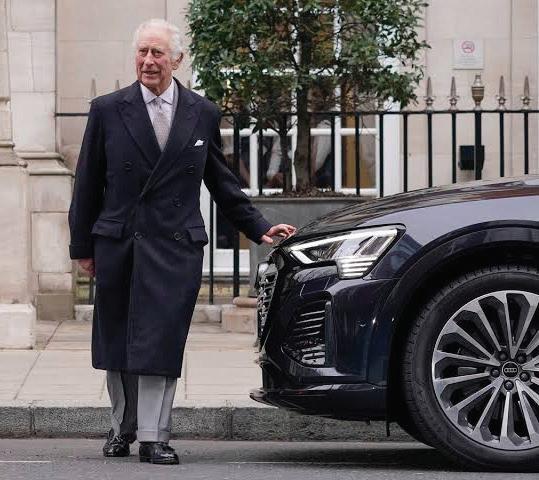
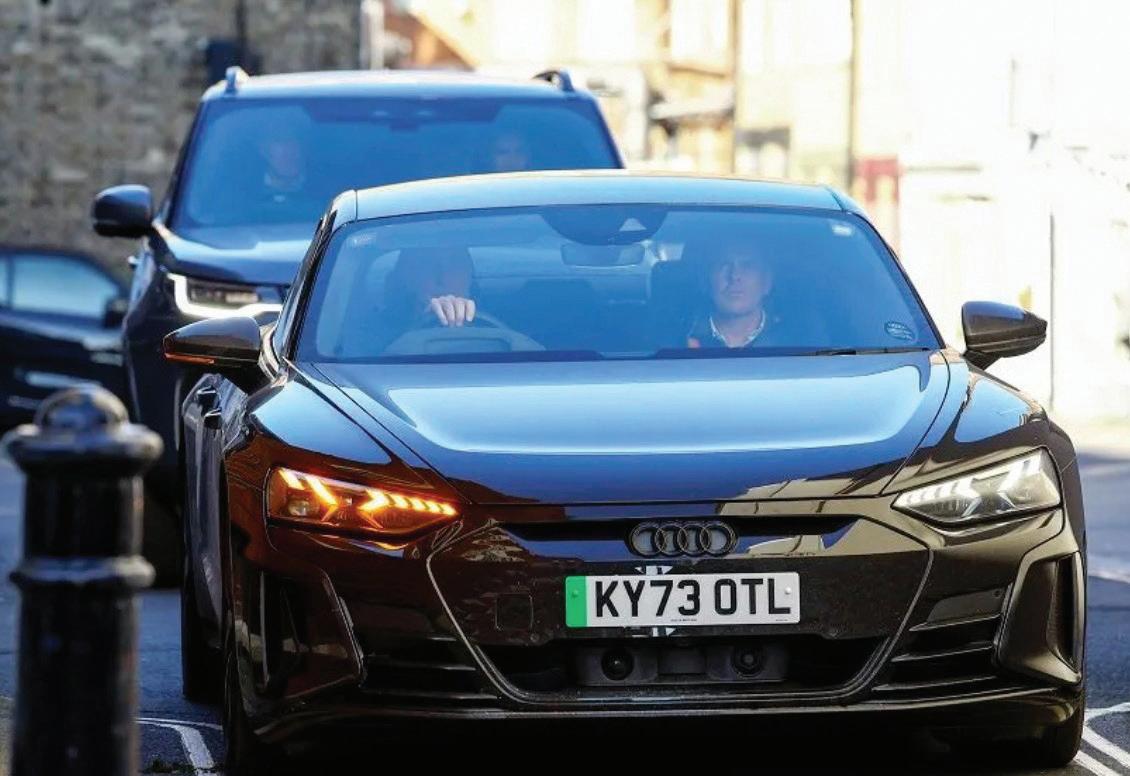

Grab Philippines today announced significant strides in enhancing the reliability of its transportation services for Filipino commuters. In the first half of the year, nine out of ten passengers attempting to book a Grab ride were successfully matched with a driver in an average of just 21 seconds—a marked improvement from the previous year. This progress is humorously highlighted in a new series of videos with the tagline, “Sorry, ‘Di Mo Na Kami Pwede Gawing Excuse,” signaling to passengers that they can now count on Grab more than ever.
This boost in service reliability can be attributed to several key factors, including increased driverpartner satisfaction due to a fair fare system, the integration of innovative technologies on the Grab platform, and the expansion of the Transport Network Vehicle Service (TNVS) driver pool.
Grab continues to maintain a balanced fare structure that benefits both passengers and driverpartners. By keeping fares fair, Grab ensures a stable market where passengers enjoy affordable services, while driver-partners earn a sustainable income.
“With our data-driven tools, we’re able to offer fares that are equitable for both passengers and driver-partners, even as market conditions fluctuate,” says Grab PH Chief Operating Officer Ronald Roda. “Our fair fare system ensures that driver-partners earn a
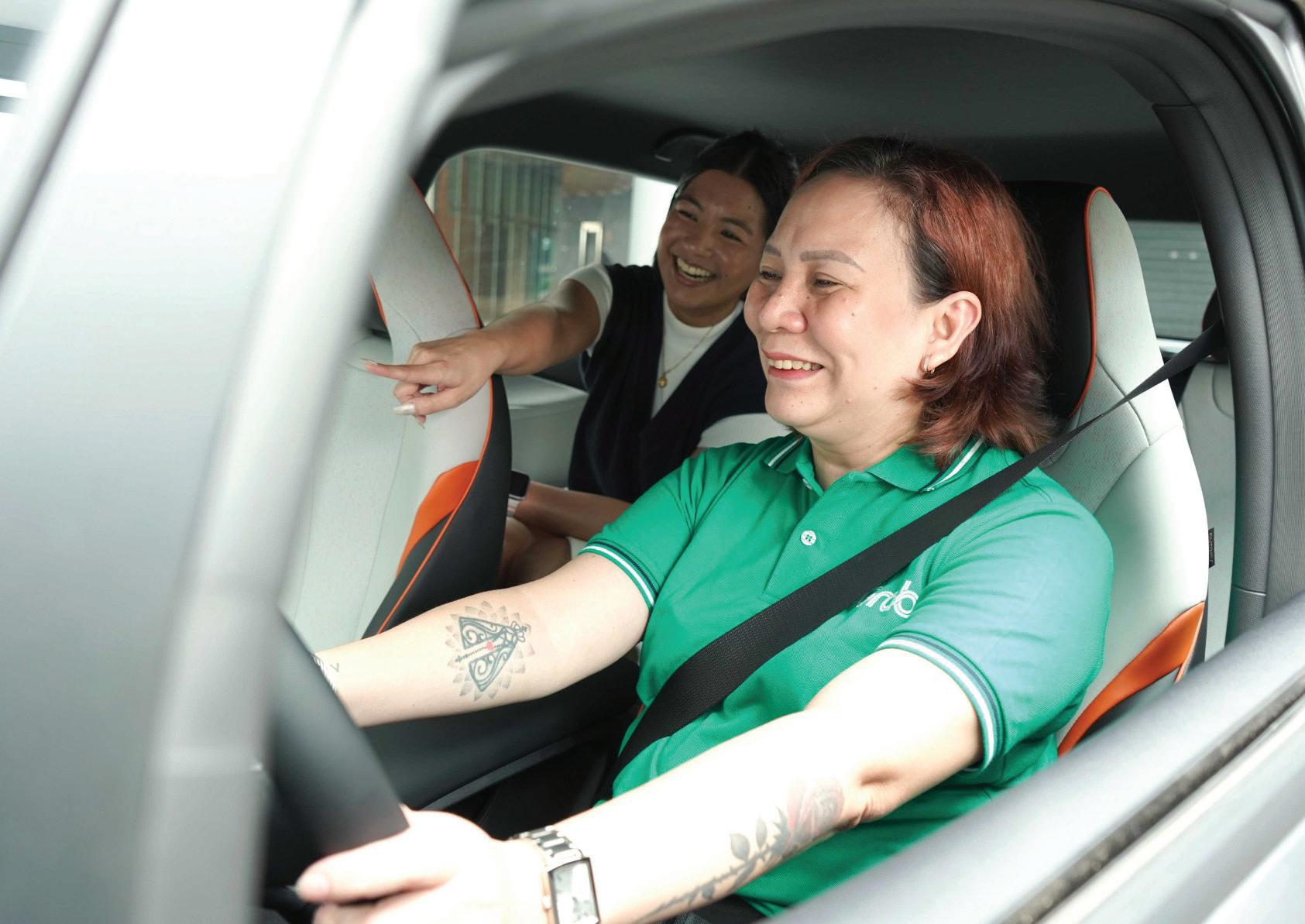
living wage—approximately double the current minimum wage in Metro Manila—while keeping our services accessible and affordable for passengers, in compliance with LTFRB guidelines.”
By continuously monitoring and adjusting fares according to dynamic market conditions, including weather, traffic, and supply-demand changes, Grab incentivizes more drivers to stay active on the platform. This, in turn, ensures that passengers can consistently book rides and reach their destinations with ease.
Grab has also introduced several innovative technologies to further enhance the reliability of its services:
Advance Booking: This feature allows passengers to book rides up to seven days in advance, ensuring timely airport transfers and reducing travel stress. Advance Booking boasts a 98% reliability rate, guaranteeing that rides will be allocated as scheduled.
Group Rides: This feature allows colleagues and groups to collaborate when booking a ride.
Passengers can initiate a Group Ride via a widget on the transport page and choose to “Arrive Together” or “Depart Together.” Each participant can set their own stops while sharing a standard base fare, making the journey more economical. Features like Group Rides and GrabShare improve reliability by optimizing vehicle use and accommodating multiple passengers.
Multi-Taxi Type Booking: This feature enables users to book different types of cars in one go, potentially reducing booking time. The nearest available

car—whether a GrabCar four-seater, six-seater, or a regular GrabTaxi—will be allocated, ensuring faster service.
Grab also empowers drivers with tools like the Ride Guide, which directs them to high-demand areas, further enhancing booking reliability.
In 2023, the ride-hailing industry moved closer to achieving a demandsupply equilibrium, thanks in part to the LTFRB’s release of around 25,000 TNVS slots. This has significantly boosted Grab’s performance, reducing the average pickup time to approximately six minutes, giving users ample time to prepare and reach their pickup points. This improvement stems from increased vehicle availability and more efficient operations.
“As we continue to grow and solidify our position in the Philippine ride-hailing industry, Grab remains committed to improving the lives of both our passengers and driverpartners,” says Ronald Roda. “Our goal is to offer the very best that Grab has to provide, fostering a more connected, efficient, and sustainable future that benefits everyone in our ecosystem.”
With these ongoing enhancements, Grab Philippines reinforces its commitment to delivering reliable, efficient, and accessible transportation services to all its customers.
Get to know more about Grab Philippines at https://www.grab.com/ph/

Lexus challenges the notion that there is insufficient demand for plush small cars

We like
Compact premium car billing fills an underserved gap in the market
Smooth, economical and stress-free powertrain
Interior lives up to the brief
We don’t like
Suspension is on the firm side and the refinement could be better
In-car tech isn’t flashy enough for those who are after that sort of thing but is too annoying for people who want a bit of zen
Powertrain seems mismatched with the dynamic chassis
hy couldn’t you have a small luxury car? If you’re not burdened with a lot of people or stuff to carry, you might still want something with high-end interior materials, sound insulation and ride comfort, while also enjoying the zippiness and easy manoeuvrability of a compact car.
It sounds like an obvious idea, but it’s one that very few manufacturers have ever put into practice, and fewer still have been able to make a commercial success of.
Only Mini has really been able to convince sufficient numbers of buyers to pay more for a small car. The first generation of Audi A1 did quite well, but the second generation struggled to repeat that success and is now unlikely to be renewed for a third run. The Audi Q2 has equally failed to set the sales charts on fire. Vauxhall tried to convince us it was a premium manufacturer for a short minute with the Adam, but few people bought either the claim or the car.
The modern-day Toyota Motor Company is bold and won’t be deterred, so it has come up with the Lexus LBX. Loosely based on the Toyota Yaris Cross, the LBX isn’t just a see-what-happens experiment. LBX informally stands for Lexus Breakthrough Crossover and the model is the first Lexus to be developed specifically with European tastes in mind. As such, Lexus hopes it will appeal to younger buyers than most of its cars, targeting 6000 UK sales a year.
If you were to refer to the LBX as a leather-lined Toyota Yaris Cross, Lexus’s engineers would probably take offence, because they have done rather more to the shared bones than that. Naturally, it uses the same TNGA-B platform (the last letter indicates the B-segment) and a version of the same hybrid powertrain, but engineers claim the two were developed separately.
Indeed, just the powertrain, which you might assume to be exactly the same three-cylinder hybrid as in the updated Yaris, exhibits a few key differences. The LBX’s electric motor produces 9bhp more (if no more torque) than the Yaris’s, and to make sure that there’s enough juice for the motor, there’s a larger battery with one whole kWh of capacity (versus the 0.76kWh in the Yaris) and a different chemistry: nickel-metal hydride instead of lithium ion. Lexus says that its new ‘bipolar’ battery is well suited to rapid-charge and discharge demands in non-plug-in hybrids, and the higher electric power of the LBX.
‘E-Four’ four-wheel-drive versions will join the range later in 2024 and feature a 6.3bhp (no, not 63bhp), 38lb ft induction motor on the rear axle. Evidently, it does little
The LBX comes with only one basic powertrain: the 1.5 full hybrid. It is normally front-wheel drive, but a small motor on the rear axle can be added for all-wheel drive. This is a £1300 option, but only on two top trims (Takumi and Takumi Design), hence the large price difference. There are no fewer than seven trim levels, but apart from paint and wheel choices, there are no separate options.
for performance (the four-wheeldrive version takes 0.4sec longer to reach 62mph) and is simply there to provide additional traction in slippery, low-speed circumstances.
The 1.5-litre naturally aspirated three-cylinder engine has the same power and torque output as in the Yaris but gains a balance shaft, which produces ‘negative’ vibrations to cancel out those of the engine and thus make it smoother.
That’s the first in a list of tweaks to make the LBX a proper Lexus in terms of NVH refinement. The noise of the doors closing has been tuned with damping sheets inside the panels, and there is additional sound-deadening material in the roof and underbody. The top trim levels (Takumi and up) also get acoustic glass and active noise cancelling.
Unlike the Mini (with its multi-link rear suspension), the LBX largely follows the small-car playbook with MacPherson struts up front and a torsion beam at the rear, although the four-wheeldrive version trades the latter for double wishbones. The steering column features an intermediate shaft with an expansion/ contraction mechanism that helps absorb vibrations.
And while the obtuse all-moderncars-look-the-same crowd might disagree, the LBX is a very different car on the road from the Yaris Cross, sharing no body panels with the Toyota. The LBX has a 20mmlonger wheelbase for 10mm greater length overall. It adopts a new generation of Lexus design, which tones down the ‘spindle grille’ a


The Lexus ‘spindle grille’ still features, but the top part has been made much less obvious. Unlike cars that have a big Lexus badge in the grille to hide the radar sensor, the LBX needs a square cut-out for the same.

Entry-level versions get 17in wheels, but most trims have 18s, like our test car. Even with the bigger wheels, there’s a fairly tall sidewall, so they probably don’t carry much of a ride comfort penalty. Depending on the trim, there are a few wheel styles to choose from.

The door handles are the same as on other recent Lexus models. They look conventional but are actually electronic. You squeeze a rubber pad to release the door. Worryingly, there’s a knack to using the manual override.

The two chief design cues of the 2020s are present and correct: an LED light strip across the rear of the car and the brand name on display instead of a logo. Porsche gets away with it, but the spelt-out Lexus looks a bit try-hard.



*Manufacturer’s homologated figures





With just two pedals to package, placement is very normal. Unlike the Yaris, but like other, bigger Lexuses, the LBX has a floor-hinged throttle pedal, which helps with the grown-up feel.
LED headlights are standard, with matrix beams an option.
tad and integrates it more into the front mouldings. Compared with the Yaris, the A-pillars are set further backwards for a longer bonnet, and with a bit of goodwill you can even see the flared wheel arches Lexus’s literature mentions. Unfortunately, the resulting drag coefficient is rather high, at 0.34.
The first thing you notice when you open the door to the LBX is that Lexus has absolutely succeeded in making the interior feel very upmarket, just shrunken down from, say, an RX. The design is restrained and modern but not reductionist and simplistic like a Tesla or a recent
Range Rover, while the materials are appealing, with copious soft-touch synthetic leather that’s indistinguishable from the real thing. The 9.8in touchscreen doesn’t dominate because it is nicely integrated into the dashboard architecture and there’s a fair selection of physical buttons, such as for the temperature, driving mode and auto hold. Some climate controls are accessed via the screen, but they are displayed permanently. If this were a more typical Lexus, one might take issue with the slightly insubstantial temperature rockers and the satin metal-effect plastic centre console, but the feel of the LBX’s interior still seems like a cut above what you would find in the (larger, more expensive) Cupra

Formentor or Mercedes-Benz GLA.
The ‘shrunken-down’ aspect is equally significant. The LBX’s calibre of plush materials causes some sort of cognitive dissonance with the narrow centre console and how close you are to your passenger. You do get used to it because it is simply a function of the car’s exterior dimensions, as is the slight shortage of passenger space. Taller testers had to slide the driver’s seat all the way back to get comfortable, which precludes anyone other than small children sitting in the back. But to regard this as a major failing of the LBX would be to miss the point of a deliberately small car. The boot, on the other hand, is surprisingly deep. While the LBX offers a mostly
convincing luxury car experience, it falters with some unnecessarily annoying tech. First up are the nannying bings and bongs to warn you of various things one shouldn’t need to be warned about. Do you really need to be reminded that the door is open or that there might be someone on the rear seat? Pressing ‘agree’ or ‘not agree’ to some legal verbiage every single time you start the car gets tiresome as well.
The ‘touch tracer’ steering wheel buttons (on Premium Plus trim and up) were likewise found to be a little annoying, at least by some of our testers. The idea makes sense: they are unmarked but configurable, and when you touch them, a legend pops up in the gauge cluster or headup display. You can also switch


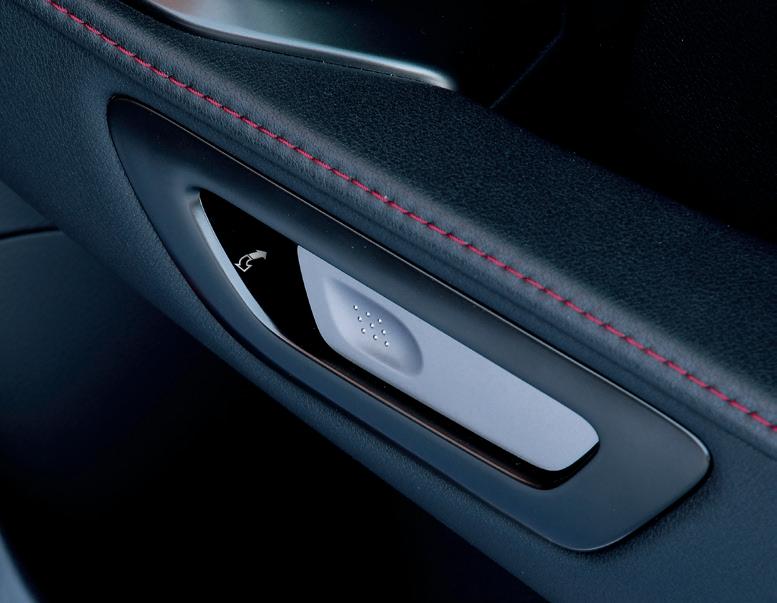

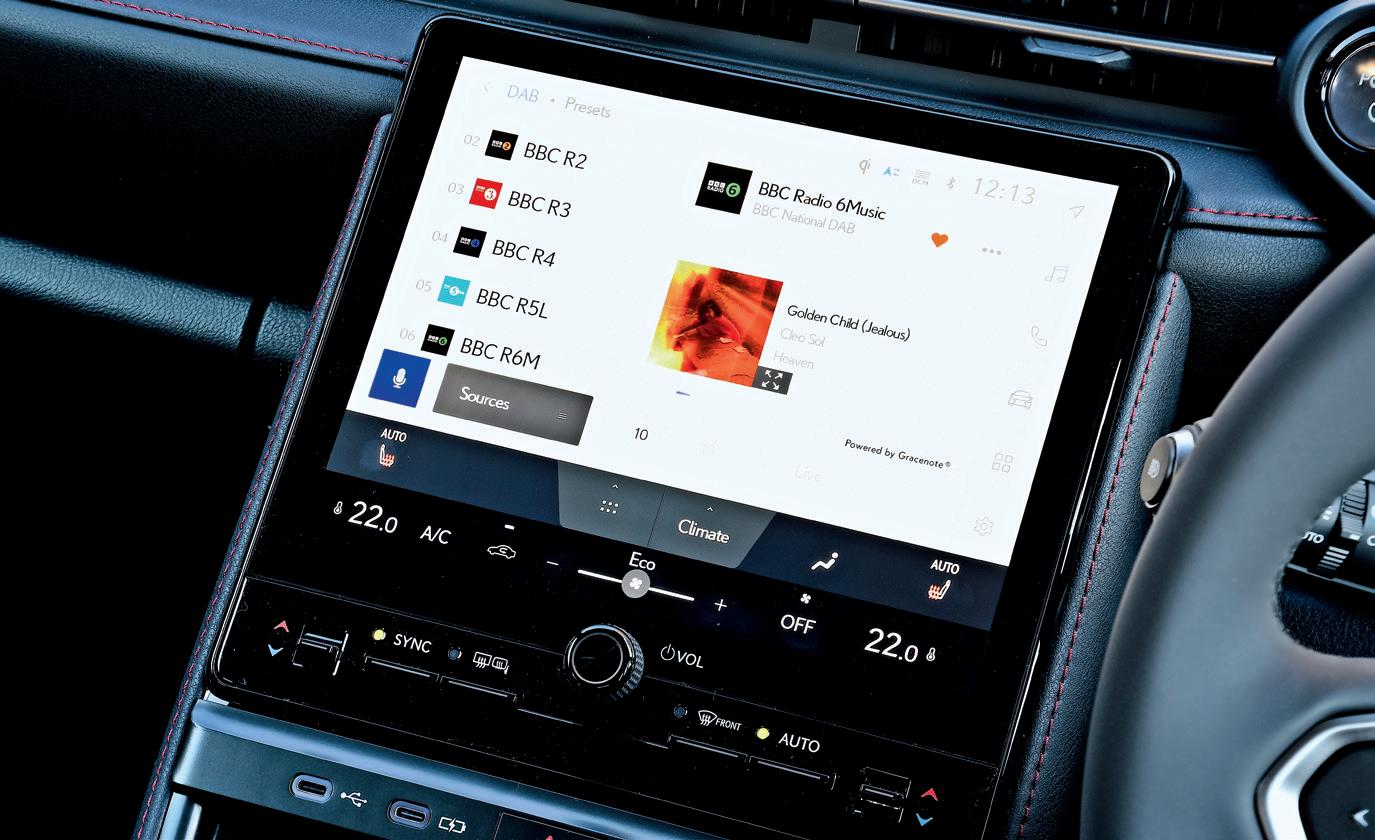
The LBX uses the same multimedia as other recent Lexus and Toyota models. It’s a fairly rudimentary interface that works well in a Yaris but doesn’t feel entirely appropriate for a luxury car. Unlike in a Mercedes-Benz or Genesis (where the system does share its bones with cheaper Kias), the interface, fonts and functionality don’t feel like an extension of the Lexus brand.
You might simply default to Apple CarPlay or Android Auto (the latter requires a cable), but this presents issues as well. You always need to agree or disagree to terms and conditions first and, due to the lack of a permanent home button or shortcut bar, exiting CarPlay to adjust the car’s settings is cumbersome.
If you do choose to use the native interface, the menus are logical enough and respond quickly. However, the native navigation system isn’t particularly clear.
The six-speaker sound system that was standard on our Premium Plus Design test car sounded mostly unremarkable. A 13-speaker Mark Levinson system comes on
❝
You can do plenty of miles and rarely even hear the engine ❞

between two presets for each side using the button underneath. In practice, however, the limited choices you get for mapping them are not very useful, and the standard selection is poorly thought out: when using cruise control, you are locked out of switching the display layout. The buttons are also not very responsive and usually require multiple presses to engage.
Toyota’s full hybrid powertrain is simultaneously simple and complex. The core concept that goes back to the first Prius is a supremely elegant piece of engineering, because it puts the petrol engine and two electric motors (one larger drive motor and one smaller motor that works as a generator and to vary the gear ratio) in a planetary gearset to create a
hybrid powertrain that behaves like a CVT, and where all components can work together without having to engage or disengage.
It’s too complex a concept to explain fully here, but the end user can simply put petrol in the tank, select D and squeeze the accelerator to go. As a stress-free way to power what is supposed to be a stressfree car, it has a lot going for it. Indeed, while dual-clutch automatic gearboxes can be less than smooth, the LBX’s CVT is impeccable.
If you take it gently, the threecylinder engine is quiet too. The clever throttle mapping in Eco mode inspires a relaxed driving style without getting the feeling that the power is being artificially limited, as Eco modes often do. You can do plenty of miles and rarely even hear the engine. Put your foot down and the LBX can be surprisingly brisk too: 8.4sec to 60mph is perfectly

acceptable for a car like this. However, it is possible to catch it on the back foot. Successive demands for hard acceleration that don’t give the car much chance to regenerate energy can quickly deplete the battery, which means the electric motor can’t deliver full power. As a result, subsequent 0-60mph runs took 8.8sec, 9.5sec and 10.6sec. This isn’t just a product of the test track: you can feel it during spirited driving on a B-road, or when you need to accelerate after having pootled through town on mainly electric power. The three-pot then starts to sound coarser and noisier.
Braking is by wire, and while the pedal is a bit too light and sensitive for our liking, it is possible to attune to and achieve smooth stops. Repeated emergency stops are unproblematic in terms of stability and stopping distances. However,
the very noisy pump (we are unsure whether this is the pump for the ABS or the one that generates the brake pressure itself) and excessive suspension pitching make the experience more startling than it ought to be.
With a powertrain that is smooth, relaxing and economical but has little sense of fun, you might imagine that the engineers would have gone for an equally smooth and relaxing chassis set-up. They haven’t – not entirely. The LBX is a surprisingly firmly riding car and the medium-speed ride is busier than we would like. However, fairly tall-sidewalled tyres and well-controlled damping mean that the ride still feels quite plush and expensive, and even though the firmness felt wrong at

The LBX clearly shares much of its assistance tech with Toyota models and as such is generally quite mature. Lane keeping is not very intrusive, and while there are adaptive cruise control systems that deal better with other cars cutting in and that have cleverer lane following, it’s mostly pleasant and gives you the option to switch to standard cruise control. The blindspot monitoring has only a visual warning. The overspeed warning leaves no margin before it starts beeping. There’s an accessible shortcut button to turn it off, but that also gets rid of the visual speed limit indicator in the gauge cluster. The former can be deactivated and the latter kept, but only if you dig much deeper into the system’s ‘notification’ settings.
The standard driver monitoring system uses a camera mounted on the steering column. It is fairly sensibly tuned and gives few false positives. However, it is keen to remind you it’s not working correctly when you’re wearing sunglasses.
first, the more we drove the car, the more the togetherness of the chassis made sense.
Given the firm suspension, it’s not a complete surprise that the LBX can serve up a fair bit of entertainment when you drive it with more commitment. It grips relatively hard, and the nose bites into corners with plenty of enthusiasm. Lift off in a corner and the chassis is quite keen to rotate positively, before the electronics bring it into line at least.
Our initial impressions were that the steering was a tad oversensitive around the dead-ahead despite its generous 2.7 turns lock to lock, but we got used to it. You never get much of a sense from the steering of how much grip there is, however. COMFORT AND ISOLATION
So, the LBX rides a bit too abruptly for its luxury car brief, but what
AUTONOMOUS EMERGENCY
BRAKING
Does the system avoid false activation well? 3
Can it be deactivated? 3
Does it have pedestrian/cyclist detection? 3
LANE KEEPING ASSISTANCE
Is the system tuned to keep the driver engaged at all times? 3
Is it adjustable for sensitivity? 3
Does it allow you to drive around a pothole/obstacle within your lane easily and without deactivation? 3
INTELLIGENT CRUISE CONTROL
Can the system consistently recognise and automatically adopt motorway gantry-signed variable speed limits? 3
Does it prevent undertaking? 3
Does it have effective audible or visual alerts, or steering intervention, to prevent changing lanes into the path of an overtaking car? 3
about the rest of the refinement picture? Well, despite promises of additional sound deadening, the LBX still seems to suffer from its small-car underpinnings. Noise refinement at speed is fair, but no more than that. While 68dBA at 70mph is good for a car of this size, we expected Lexus’s refinement objectives to be loftier with the LBX.
Higher trims come with active noise cancelling and acoustic glass for the front windows and windscreen. We have yet to try one of those, but it might make a meaningful difference. Even on our test car, vibrations – whether from the powertrain or the suspension – were all but absent.
Toyota and Lexus tend to get seat comfort right, even on entry-level trims, and the LBX is no different. They are padded supportively and come with adjustable lumbar support. A cushion tilt function

was absent on the manually adjustable seats of our test car, which is unfortunate, but thigh support is still adequate. The seat is set medium-high for a crossoverappropriate driving position, and the steering wheel comes with plenty of adjustment.
Prices for the LBX start at £29,995, rising to £35,605 for a mid-spec Premium Plus Design and £40,005 for the range-topping Original Edition. That’s a lot of money for a small car, especially when you could drive out of the same dealership with a Toyota Yaris Cross for £25,530. But that would entail quite a few sacrifices in terms of refinement, power and perceived quality. With similar equipment, an Audi Q2 demands about the same outlay as the LBX, a DS 3 or Peugeot
2008 slightly less. Bigger cars such as a Cupra Formentor or Mercedes GLA are evidently more pricey. With its proven hybrid drivetrain, you can expect an LBX to be economical, although it does depend strongly on the kind of driving you do. In our 70mph touring test, where there was no regenerative braking, our test car returned only 45.2mpg. Over the course of the complete road test, it did better, at 52.7mpg. Given that included performance testing and plenty of motorway driving, you can expect even better in the real world, particularly if you do a lot of suburban and town driving.
As usual with a Lexus or Toyota, there is the reassurance of the company’s strong reliability record. As standard, all Lexus models come with only a three-year/60,000-mile warranty, but a year and 10,000 miles are added with every service, up to 10 years and 100,000 miles.
The LBX uses the same ‘B’ version of Toyota’s TNGA platform as the Yaris (Cross). The suspension layout is the conventional arrangement of MacPherson struts and torsion beam, though all-wheel-drive versions get rear double wishbones and a small electric motor on the back axle. The weight distribution of our front-driven test car was 60% front, 40% rear.
LBX should hold its value very well compared with premium and semipremium rivals but can’t touch the Mini.


The LBX convinces as a small premium car, but only just
The idea of a car that is small but not cheap is an appealing one. Small cars may not be practical in the load-lugging, people-carrying sense, but they are practical in plenty of other ways, and injecting some luxury makes a lot of sense.
The LBX ticks some but not all of the boxes we hoped it would. Its interior ambience and perceived quality are convincing, and the smooth and economical hybrid powertrain is ideal for gentle cruising. Its road manners take a bit more warming to. While we feel that Lexus could have done more to make the LBX feel comfortable and refined, the surprisingly dynamic chassis and firm but well-damped suspension do hold some appeal as a more controlled- and resolute-riding route to refinement.
Although the LBX avoids feeling wilfully techy when it comes to driver assistance and infotainment, some of the systems lack the attention to detail that would make them more user-friendly. But with that greater attention and care applied not only to the software, but also the car’s suspension tuning and equipment levels, the LBX could easily yet become the rounded, well-resolved small luxury car we hoped it would be.

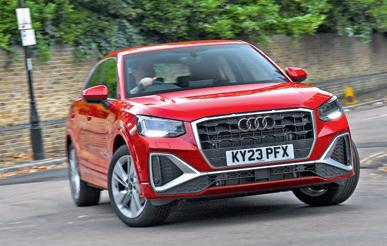


The 2008 feels quite posh and rides well. A high price, poor infotainment and divisive driving position limit its appeal, though.
ILLYA VERPRAET
I’d like the LBX much more if it weren’t so meddlesome. By all means add a bong to remind the terminally forgetful to close the door and retrieve their child from the back seat, but let me turn those alerts off, please.

RICHARD LANE

The Morizo RR Concept is an LBX with running gear from the GR Yaris. Given a lot of those are bought by people who already own a couple of supercars, I think a GRfettled LBX – effectively a plusher GR Yaris – could catch on. A version with 200-odd bhp and FWD would also be appealing.
£35,605
£35,110
£30,110 134bhp, 170lb ft 9.2sec, 126mph 112g/km, 56.5mpg
£31,980 134bhp, 170lb ft 8.3sec, 128mph 111g/km, 51.1mpg
Make the
or

MINI COOPER C EXCLUSIVE L2
We have yet to drive the updated petrol Cooper. Three doors, so quite small, but should be decent to drive. Now auto-only and has the EV’s minimalist cabin.
£27,350
154bhp, 170lb ft 7.7sec, 139mph 134g/km, 47.1mpg

Make mine a slightly

hat’s a very cool car,” coos the cyclist as he pulls up alongside us at a set of traffic lights in central London. He’s far from the first of our fellow road users to offer this positive appraisal, and we’ve been on the road for barely 15 minutes.
As the signals turn green and we move away he chimes in with another observation: “Wow, it’s electric – that’s amazing.” Again, we’ve heard this before, and we’ll continue to hear it for the rest of our jaunt around the capital.
Our two-wheeled friend keeps pace with us for 100 metres or so before the traffic slows again and he’s able to slip ahead through the snarl-up. However, just as he disappears he takes one more glance back at us and, with a big grin, shouts: “You have the best day!”
It’s an unexpectedly generous and friendly wish from a resident of what is traditionally the UK’s grumpiest city, but it’s also a largely unnecessary instruction because, frankly, we’re already having a whale of a time. Despite being not only in what is likely to be the slowest and most basic car an Autocar tester will pedal in 2024 but also confined to the congested streets of London, both myself and snapper Jack Harrison, who is perched behind me, have been giggling like idiots from the moment we turned a wheel. Welcome, then, to the Bentley Blower Junior, the latest Lilliputian creation from the Little Car Company. The Bicester-based concern has already produced a number of exquisite pintsized and electrically powered recreation motors, most notably an Aston Martin DB5 and a Ferrari 250 Testarossa, but the Bentley is the firm’s first road-legal offering, hence our chance to sample it on public roads. London’s traffic-clogged highways and byways might seem an odd place to launch a new car, but the choice of location is actually a stroke of genius. For starters, despite being based on a car that was bred for high-speed competition, the Little Car Company (let’s call it LCC for short, shall we?) Blower has extremely modest performance and range (top speed is 45mph, and you might be able to squeeze 65 miles out of a full battery), making the open road a destination only for the brave or the foolhardy. Moreover, London is also the birthplace of the Bentley brand: company founder WO Bentley assembled his first car here in the capital back in 1919. In fact, you can still visit the site of the very modest workshop where it all started. Located down a quiet mews just around the corner from Marylebone Station, 47 Chagford Street has long since been turned into a residential property, but a small blue plaque pinpoints the exact place where a motoring legend was born.
We pull up outside to take a few shots, and the pause in proceedings proves to be the perfect

opportunity to take stock of LCC’s handiwork. It’s the largest, literally, project it’s taken on, the car’s 85% scale being an increase from the usual 67% to 75% range it works in. Even so, the Blower Junior still fills less space on the road than a narrow-bodied Caterham Seven.
Like all of LCC’s line-up, this is an officially licensed product, hand-crafted using extensive 3D imagery of the original machine. In this case, it’s the 1929 41/2 Litre Bentley Supercharged Team Car No 2 that raced in the following year’s Le Mans 24 Hours. Engineered and built by original ‘Bentley Boy’ Sir Henry ‘Tim’ Birkin, the full-size machine (see separate story, right) is now part of Bentley’s heritage collection.
Where possible, original materials and production methods are used in every LCC build, so the Junior’s aluminium body panels are handformed, while the seats and interior are trimmed in the same Dark Green Lustrana hide found in the 12 Blower Continuation Series cars that were produced from recreated components in 2020.
There’s also a machine-turned dashboard packed with period dials, repurposed in a couple of cases to show the battery capacity and the motor’s current output, while the large fourspoke steering wheel is rope-wound, like the original, although in the Junior it sits ahead of a centrally mounted driver’s seat. Only a TFT display for the clock and a rather incongruous pair of posts for the seatbelt mountings spoil the otherwise period-perfect picture.
Under the skin there’s a ladder-frame chassis that carries the body and leaf-sprung suspension complete with friction dampers. Of course, and unlike its rather larger great-grandfather, there’s no bellowing supercharged four-cylinder engine; power (and we use that term in the loosest possible terms) instead comes from a 20bhp motor that drives the rear wheels through a single-speed reduction gear, while the only noise is an incongruous space-age whine from the pedestrian-warning sound generator.
There’s also a 10.8kWh battery, which in a particularly neat touch is recharged through a CCS port hidden in the fake supercharger housing sticking out from the bottom of the grille. Other deviations from the original include a light and strong carbonfibre tub for the body structure in place of the original’s ash frame, although it is covered with the period-correct impregnated fabric for that authentic 1920s look.
With the pictures committed to memory card, we climb aboard and continue our tour of London. Our next logical stop-off should be the suburb of Cricklewood, where WO moved his operations months after starting the company, but that’s a six-mile, traffic-strewn schlep away and we’ve only got the car for a few hours.

❝
We feel like we’re bowling down the Mulsanne Straight, giving it the full Birkin ❞

Besides, the original Blower was actually cobbled together at Birkin’s own premises in Welwyn Garden City, Hertfordshire, and with only around 40% charge we would struggle to get there, let alone make the return trip. Instead, we decide on a sight-seeing trip to take in some thoroughly British tourist traps in our suitably Union flag-adorned Racing Green tour bus. Getting out of the narrow mews is a doddle, the Bentley barely stretching the tape measure at a slim-hipped 1.5 metres (4ft 11in in old money). Those compact dimensions and a panoramic view out – there are no windows to speak of, nor a roof, but true Bentley Boys never put the hood up anyway, even in the wettest and windiest weather – mean the Junior is perfect for sliding into the smallest gaps in the traffic. It’s so narrow, in fact, that you soon forget about flicking the Bakelite-like switch for the indicators






Despite its legendary status, the Blower Bentley was viewed with disdain by old man WO. When it came to engines, he believed, bigger was better, so he was never fully on board with the idea of forced induction.
Instead, Sir Henry Ralph Stanley Birkin, one of the original squad of upper-crust racers known as the ‘Bentley Boys’, was the driving force behind the project. He set up a separate workshop in Welwyn Garden City and drained the deep pockets of benefactor and socialite Dorothy Paget to fund development. Believing a smaller and lighter racer was needed to take on the might of Mercedes, he bolted a Rootstype supercharger onto the existing 4.5-litre four-pot, which in racing form developed 240bhp – more than WO’s 6.5-litre Speed Six models.
Unfortunately, reliability wasn’t as easy to come by as power, with Blowers failing to finish at Le Mans in 1930. Even so, the car’s performance and back story meant it gained fame despite a lack of results, and today it’s arguably the bestknown Bentley of the lot.

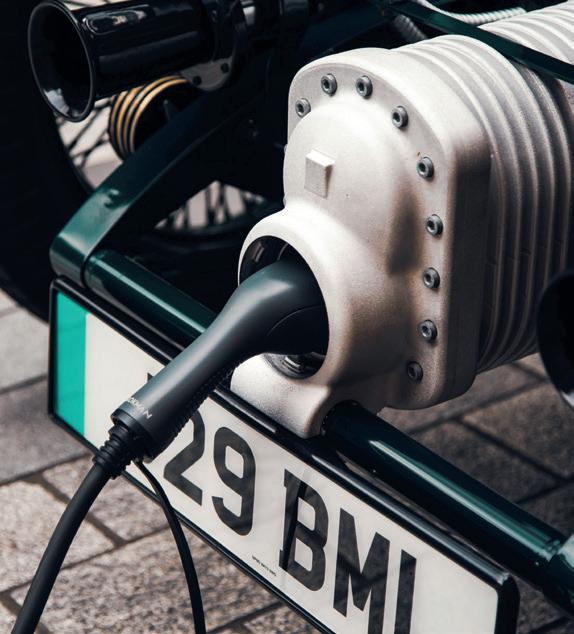
and instead use your outstretched arms as turn signals, pushbike-style.
Given London’s blanket 20mph speed limit and frequent jams, we’ve got the car in Comfort mode (there’s also Bentley and Sport settings, each accessed by twirling a wooden rotary switch on the dash), which limits power but increases the battery regeneration when slowing to halt. Even so, there’s more than enough acceleration to keep up with the (slow) flow of traffic, and because you’re so exposed, even 15mph feels perilously quick as you’re gently blown around by the elements. Eyewear is a essential, because the small aero screen is next to useless.
On the one short stretch of dual carriageway we encounter on the run back to the car’s base deep in the bowels of Westfield shopping centre, we get to engage Sport and unleash the full 20bhp. Hunched over the wheel, shoulders tucked in and teeth gritted, we feel like we’re bowling down the Mulsanne Straight and giving it the full Birkin, even though we’re only just nudging the posted 40mph limit.
The sense of flat-out fun is enhanced by the bone-shaking ride from that leaf-sprung suspension and vintage-spec handling that makes every roundabout, junction and widthrestricting chicane a real elbows-out affair. The light but fairly long-winded worm-and-roller steering feels vague around the straight-ahead and lacks any real self-centring, but happily the modern disc brakes are strong and operate with surprisingly good feel.
Yet none of this matters, because this car is about so much more than raw statistics and honed driving dynamics. For most of the day we rarely exceed 20mph, and, well, that’s just fine. Instead, we revel in the sense of occasion and, yes, I’ll admit it, the attention.
As we move past the Houses of Parliament and Buckingham Palace the throngs of tourists turn their smartphones from the centuries-old attractions to the shrink-rayed Bentley. Every time you stop there’s a barrage of questions and big grins, which only get broader as you give them a blast of the car’s Toad of Toad Hall klaxon as a parting shot. As a feel-good mode of transport, the Blower is hard to beat.
Objectively, of course, the LCC Bentley makes no sense. It offers meagre performance, a limited range and absolutely no protection from the weather. And then there’s the thorny issue of price, because at £108,000 this is one very expensive plaything – although with just 99 examples planned, exclusivity is guaranteed.
Yet anyone with the means could spend 20 times this sum on an unobtanium hypercar and not garner 10% of the attention or, crucially, the goodwill. Wherever we went we were welcomed with open arms by pedestrians, cyclists and other drivers alike. Simply put, they love the baby Blower. And so do we.

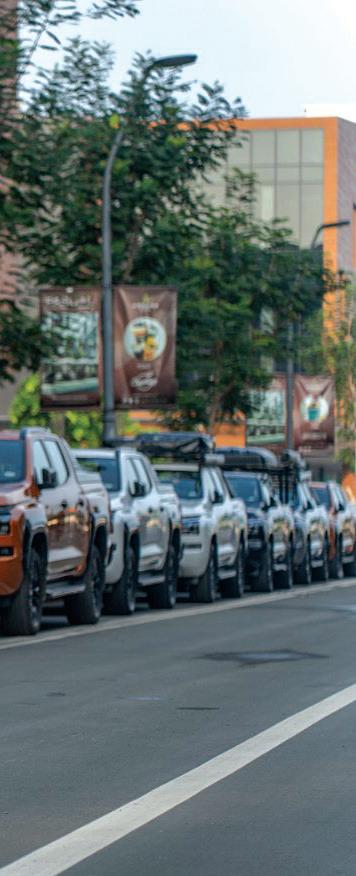
Mitsubishi Philippines launched the All-New Triton pick up earlier this year and just recently invited us on an experiential drive, as brands usually do when they introduce an all-new model. This time, we were to drive to Bataan. The variant we would drive on this trip would be the top of the line Athlete 4x4 AT in Yamabuki Orange.
The All-new Triton has a completely new look, and is bigger in all dimensions over the last generation Strada. Up front, Mitsubishi’s Dynamic Shield concept has been updated, and still aggressive. The Multiprojector LED headlights and LED daytime running lights have the same layout and with LED tail lights around the rear. There’s quite a bit of piano black trim around the grille and headlights all the way down to the brushed aluminum garnish which hides a thick steel bash plate used to protect the under the radiator and engine. The
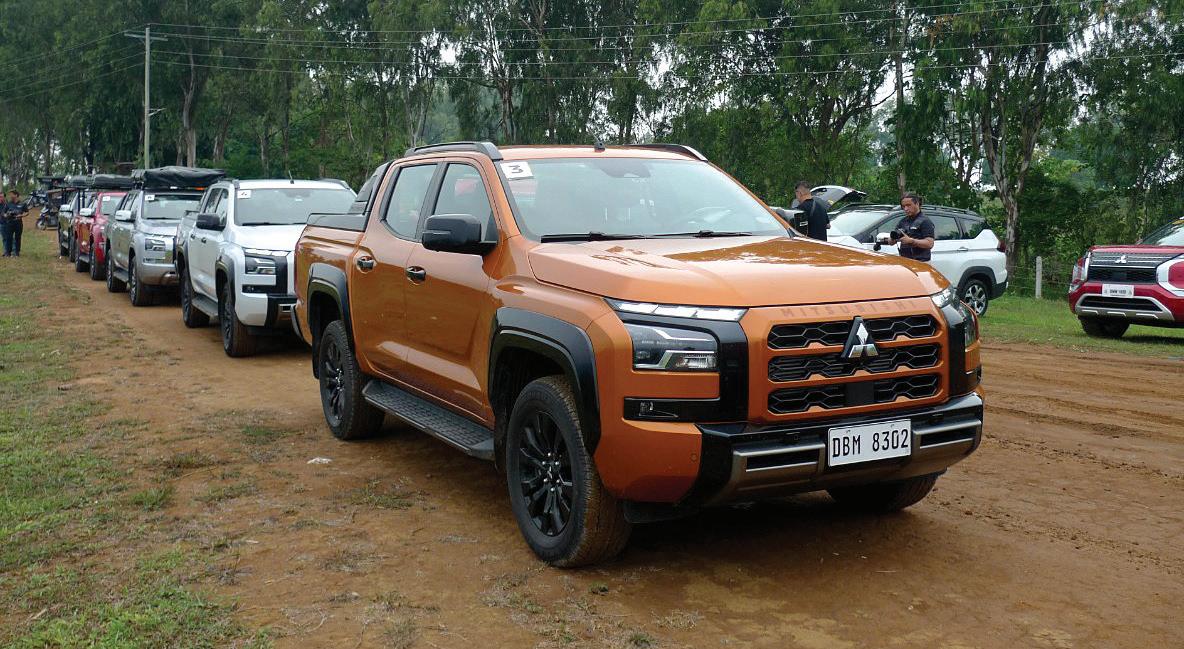

piano black wraps around the bottom of the front bumper to the wheel arches, which match the18” glossy black alloy wheels wrapped in 265/80’s.
Getting in is easy with the Keyless Operation System. Starting and turning off the engine is easy with the Engine Start/Stop button. The driver’s seat is easy 10-way power adjustable while the front passenger seat is 4-way manual adjust. The seat material is orange synthetic leather with black suede inserts.
Our start point was Parqal Mall near Macapagal Blvd., and we would take NAIAX through Skyway 3 to NLEX to make our way to San Fernando Pampanga. We would be a comfortable three to a vehicle to make sure there was enough space for our gear and sizeable snack stash in the back seat.
In other countries, pick ups are work trucks and not unusually, covered in a coat of dirt or mud. Here, some never
really get dirty. Some. Since overlanding has grown popular, it is good to see quite a few of these getting up to their rims or even bumpers in water or mud. Modern pickups like the Triton now offer more creature comforts and offer a more civilized ride than the past.
That said, they make good daily drivers, especially since they now offer comfortable seats, more leg room for the rear
occupants, and have amenities that make an often unwieldy vehicle tame-able for the city, like the 6-speaker infotainment system with it’s 9” touchscreen display with AM/FM radio, Bluetooth telephony and audio, USB connectivity, Wireless Apple Carplay and Android Auto and wireless charging. The infotainment screen also serves as the 360 camera and reverse camera screen. Air-conditioning
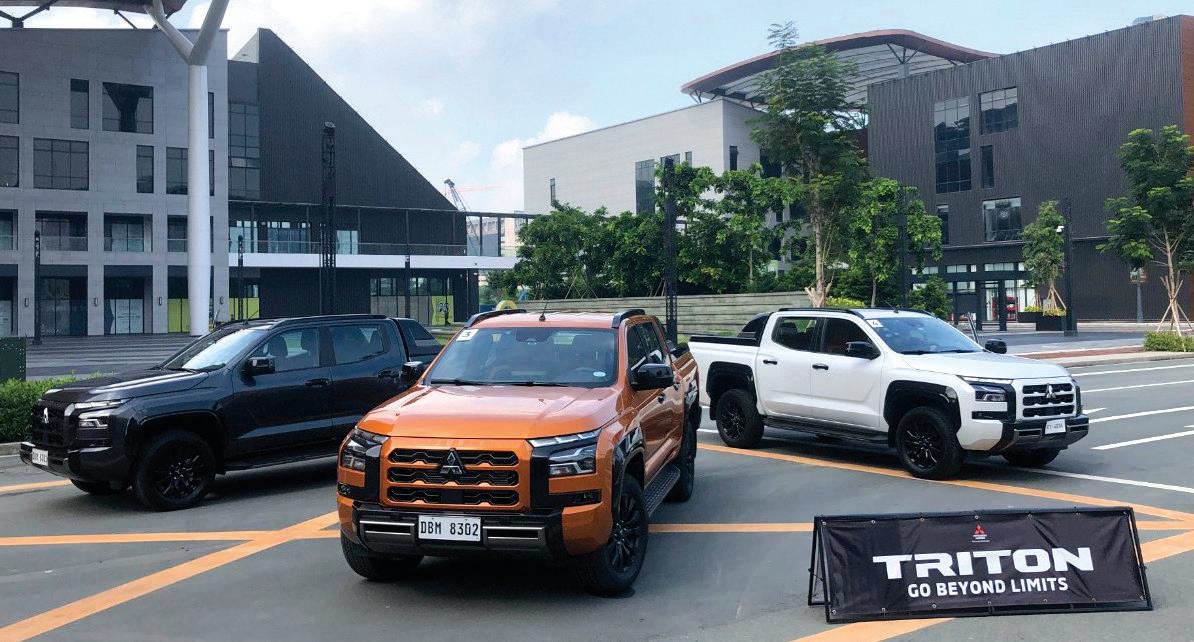

is dual zone with a rear re-circulator for the backseat occupants and there are Type A and Type C USB outlets for the front and rear occupants.
A distinct advantage a vehicle this tall, with 222mm ground clearance, in city traffic is your ability to see above sedans and other vehicles, allowing you an advantage of seeing more of the road ahead and being able to choose a better lane to take. And this was evident in the rush hour jam on NAIAX and the Skyway 3. Once we got to NLEX, it was easy, there was enough power on tap to overtake slow vehicles and just to make things interesting, we got off the expressway at Mexico and took the more populated inner provincial highway to San Fernando to Lola Nor’s, our early lunch venue. This was roughly two hours in mixed rush hour traffic to highway speeds in which the Triton breezed though.
POWERPLANT
Its powered by a Euro 5 compliant 2.4 Liter Direct Injection Diesel
with a Two-Stage Turbo putting out max power of 204Ps @ 3500rpms and 470Nm of torque between 1500-2750rpms. This is mated to a 6-speed automatic transmission. And there is a Drive Mode button which we’ll go into in a while.
After lunch, we headed to Bacolor Pampanga and on to the Mega Dike Access road, made our way past Angeles, Floridablanca, through Dinalupihan and out to
SCTEX where we would head to Bagac through more winding country roads to the Cabog Cabog View Deck to get some scenic photos if the Triton.
There was a surprise waiting for us, a short off-road course which on an ordinary day would have been easy even for the 4x2 Triton, but with the recent rains, some areas were slippery, it allowed us to fully take advantage of the high ground clearance and

the off-road capabilities of the Triton 4x4 Athlete.
The All-new Triton is equipped with Mitsubishi’s Super Select 4WD-II. This has Drive Modes paired with four terrain controls: 2H is for regular city/highway driving, this has two Drive Modes - NORMAL and ECO. 4H is for when additional traction is needed and torque split is 40% front and 60% rear, this has three Drive Modes – Normal, Gravel and Snow. 4HLc is 4WD High Range with Locked Center Differential allowing for even torque distribution to all four wheels, this has three Drive Modes – Normal, Mud and Sand, and 4LLc is 4WD Low Range with Locked Center Differential for real off-roading on challenging terrain, this has two Drive Modes – Normal and Rock.
These are all convenient shifton-the-fly, except for shifting to 4LLc. For grip on the slippery surface, we only needed to use the 4H and Normal Drive Mode setting.
It’s equipped with Active Yaw


Control born out of Mitsubishi’s rally heritage. Also, the All-New Triton also has a thicker ladder chassis giving it better torsional rigidity, which offers higher resistance to chassis twisting in extreme off road situations.
The Triton Athlete 4x4 has a comprehensive safety suite, airbags – driver and passenger
(with cut-off switch), driver’s knee, side and curtain. Three point seatbelt and seatbelt reminder for five occupants. There’s the 360 camera, AntiLock Braking System (ABS) with Electronic Brakeforce Distribution (EBD) and Brake Assist, Active Stability and Traction Control, Hill Start
Assist, Trailer Stability Assist, Hill Descent Control, Emergency Assist for Pedal Misapplication (EAPM), Forward Collision Mitigation System (FCM) with Pedestrian Detection, Blindspot Warning System (BSW) with Lane Change Assist (LCA), Rear Cross Traffic Alert (RCTA), Lane Departure Warning (LDW), Auto High Beam, Parking Sensors and ISOFIX tether anchor points.
After everyone had their fill of muddying up the Tritons, we had about a 30 minute drive to our accommodation for the evening. At the same time, the rain came down and we cut through a dirt road though some fields just because we could. Driving on a muddy dirt road is always easier and more fun in this type of vehicle. We finally made it to Rancho Bernardo and this was where we would end the official drive.
The All New Triton 4x4 Athlete definitely looks big on the outside
but is manageable when you’re already behind the wheel. It feels stable in almost all situations and has all the amenities you need. Mitsubishi’s Super Select 4WD-II coupled with Drive Modes will make short work of loose, slippery surfaces and inclines, but on a side note, we do suggest you at least get some basic training on off-roading to be able to fully take advantage of this system and read the terrain. The 360 camera is handy when offroading and in tight situations like parking or the back streets of Manila.
Priced at Php 1,909,000 the Triton 4x4 Athlete is at the lower end of the price range for top of the line 4x4 models and has just about everything the competition offers, and then some. It’s a decent looking truck for a daily driver in the city, and very capable, if you like to go off the beaten path on weekends. If you’re thinking of getting a pickup, you might want to add this to your list of options.
NEIL PAGULAYAN

Toyota Motor Philippines (TMP) has successfully concluded the National Finals of its premier e-motorsports tournament, the TOYOTA GAZOO Racing GT Cup Philippines (TGR GT Cup PH). The event, held on Sunday, August 18, at the SM Mall of Asia, marked a thrilling culmination of the competition in a live public venue for the first time.
Drawing large crowds, the TGR GT Cup PH Finals showcased the country’s top sim racers as they battled it out on their racing rigs for a chance to win cash prizes, exclusive TGR merchandise, seats in the Autocross Challenge, and the honor of representing the Philippines in the Asia Finals.
The competition kicked off with the
Quarterfinals on August 17, where the Top 40 fastest e-racers from the qualifiers faced off on Trial Mountain in the Toyota GR Yaris RZ “High Performance” ‘20. Divided into four batches of 10 players each, the participants competed in three intense race heats. The first race determined the starting grid through a qualifying time trial, while the second race reversed the grid, adding excitement as the winners of the first race started at the back. The third race was another test of speed, with racers aiming to secure higher grid positions based on their fastest laps.
Notable performances emerged from past champions, with Luis Moreno and defending champion Russel Reyes winning all three races in their respective
batches. Junior Class champion Enzo Ison also dominated his group, while former Promotional Class champion Stanley Golez and newcomer Adrian Unisa each claimed victories in their batch.
The competition intensified in the Semifinals, where the Top 20 racers competed on the Suzuka Circuit in the Toyota GR Supra RZ ’20. Similar to the Quarterfinals, the Semifinals featured three race heats per batch, with qualifying time trials setting the grid for the first and third races, and the second race reversing the order. Unpredictable weather conditions further tested the racers’ skills, with drizzle, dry conditions, and heavy rain adding to the challenge.
Luis Moreno continued to assert

his dominance in the first batch, securing an eight-second lead in the first race, followed by a close contest with Jether Miole and Enzo Ison. Moreno maintained his momentum in the second and third races, consistently finishing at the top.
In the second batch, Russel Reyes demonstrated strong and steady driving, securing first place in the opening race. Matthew Ang and Stanley Golez followed closely behind. The remaining races saw similar results, with Ang, Reyes, and Golez consistently finishing in the top three.
For the National Finals, three distinct tracks with three different cars were introduced across three race heats. The e-racers took on the Deep Forest in the Toyota GR Yaris RZ

“High Performance” 20, the Brands Hatch Grand Prix Circuit in the Toyota GR 86 RZ ‘21, and the Fuji International Speedway in the Toyota GR Supra Racing Concept ’18. With the 10 best players remaining, the competition reached its peak. The National Finals saw intense wheel-to-wheel action as top e-racers pushed their limits, much to the delight of the cheering audience at SM Mall of Asia.
In the first race, Russel Reyes initially took pole position, but a strategic pit stop by Luis Moreno allowed him to overtake Reyes and secure the win. The second race, with a reverse grid, saw Moreno starting at the back, but he fought his way to the front, finishing first, followed by Enzo Ison and Reyes. The third race introduced dynamic weather conditions, which tested the racers’ adaptability. Moreno once again demonstrated his prowess with a well-timed pit strategy, eventually taking the lead after a mistake by Jether Miole, who had been leading the race. The final lap saw a dramatic turn of events, with Matthew Ang ultimately taking the win, Moreno finishing second, and Ison third.
The official results crowned Luis Moreno as the TGR GT Cup PH 2024 Champion with 75 points. Enzo Ison claimed 2nd Place with 48 points, and Russel Reyes rounded out the podium in 3rd Place with 45 points. Special awards were also given, with Ison recognized as Driver of the Day and Ang awarded for the Fastest Lap.
“This has been a fun event. Thank you so much for giving us sim racers the opportunity to have another shot at the [TGR GT Cup]. Hopefully, there’s more to come,” shared Russel Reyes.
“Thank you to my family and friends for supporting and helping me. And to my team, Legion of Racers, thank you for the practices,” said Enzo Ison.
“I would like to thank Toyota Motor Philippines for a phenomenal event. It’s the first time we had a live event head-tohead, and it’s great to see more of these events coming out. This year, I approached training differently, focusing on being more open and dynamic, and I’m happy that it paid off,” said Luis Moreno.
Moreno, Ison, and Reyes will represent Team Philippines at the Asia Finals in Malaysia on October 13.

Zachary ‘Zach’ David secured a point-scoring 8th place finish at Circuit Paul Ricard over the weekend. Although he was expecting better results given his performance over the last few rounds, it was still a strong showing from the Malta-licensed Filipino driver during a rain-hit Round 6 of the Formula Regional European Championship by Alpine (FRECA).
The #20 R-ace GP entry was clearly down on pace during Testing. This hindered David in Saturday Qualifying and could only set the 7th fastest time amongst the Group A runners that earned him P13 on the grid for Race 1. Aiming for a Top 10 finish and making up for his low grid position, David immediately got his head down at the start and gained a spot on the opening lap. However, with such a closelypacked grid, making a clean pass proved to be difficult and forced him to hold position in P12. Another driver then
made contact with David mid-race that dropped him down to P20. Despite being far away from the points, David still chased after the pack in search for a strong result and recovered to 17th place when the chequered flag dropped.
In contrast to Saturday’s clear skies, Race 2 on Sunday got underway behind the Safety Car as a heavy downpour drenched the entire 5.842 km track. The entire 33-car grid was only given the green light on lap 3 where David again improved 1 spot up to P10. But the Safety Car had to be brought out on track once more, this time to clear the stranded cars that were caught out by the tricky conditions.
With only less than 9 minutes left on the clock, David would find himself in a tight battle for 10th as the field scrambled for position. An opportunity eventually opened up on the very last lap, which allowed David to take 8th place at the finish line to conclude a tough weekend in France on a
high note.
The Formula Regional European Championship by Alpine (FRECA) is taking a month’s break before resuming in September. Rounds 7 and 8 will be held on back-to-back weekends at Imola Circuit and the Red Bull Ring, respectively before visiting the Barcelona Circuit on the 28th to 29th of September. Finally, the 2024 season wraps up at Monza Circuit on the 26th to 27th of October.
Zach David is sponsored by Ceramic Pro, Stilo Helmets, Attard Baldacchino, Puma, Green Amenities, JG Summit Olefins Corporation, AutoPlus Sports, Automobile Association Philippines, Time Attack Manila, ISR, and Malta Motorsports Federation.
For more info and the latest updates, follow ZachdavidRacing on Facebook, @ zachdavidracing on Instagram, @zachdavid. racing on TikTok, and @zachdavidracing on YouTube.
TLast August 4, 2024, Lynk & Co Cyan Racing made a resounding impact at the 2024 TCR World Tour in Uruguay, clinching two prestigious winners’ awards and taking the lead in the overall standings. This remarkable achievement underscores the brand’s mastery in motorsport and its relentless pursuit of excellence.
Uruguay, a nation celebrated for its distinctive motorsport culture and rich racing legacy, served as the battleground for this victory. The challenging El Pinar Circuit, stretching 3.4 kilometers with 14 demanding corners, is renowned for its intricate track design and varying topography. The circuit’s narrow, uneven surface, combined with the low track temperatures typical of Uruguay’s winter, posed significant challenges for both drivers and vehicles. Yet, the Lynk & Co 03 TCR rose to the occasion, demonstrating superior performance and handling.
Against these formidable odds, Lynk & Co Cyan Racing’s drivers delivered extraordinary performances. Yann Ehrlacher, after a difficult start, rebounded spectacularly by setting the fastest time in the final Q2 session, securing pole position with a remarkable lead of nearly four-tenths of

a second. In a post-race interview, Ehrlacher credited the Lynk & Co 03 TCR’s reliability for his success under challenging conditions.
Meanwhile, Thed Björk maintained his exceptional form this season, achieving a P3 podium finish in the first race and triumphing in the second race despite starting from sixth on
the grid. Local hero Santiago Urrutia made a triumphant return to his home track, contributing significantly to the team’s success through exemplary teamwork. These victories were the result of Lynk & Co Cyan Racing’s impeccable collaboration, strategic execution, and the professional race setup of their cars.
Motorsport serves as the ultimate testing ground for Lynk & Co, where cutting-edge technology is refined and integrated into production vehicles. This rigorous process ensures that innovations born on the track enhance everyday driving experiences, offering superior performance, handling, and safety.

The Lynk & Co 03 series, developed through years of racing expertise, exemplifies this approach. The soon-tobe-launched Lynk & Co 03+ in Latin America will allow customers to enjoy racetrack-inspired agility in their daily drives.
As the racing season progresses, Lynk & Co Cyan Racing is poised to continue its winning streak and showcase its motorsport prowess on a global stage. With its imminent entry into the Latin American market, Lynk & Co is poised for significant growth, bringing exceptional products and innovative concepts to urbanites worldwide, all rooted in its rich racing heritage.

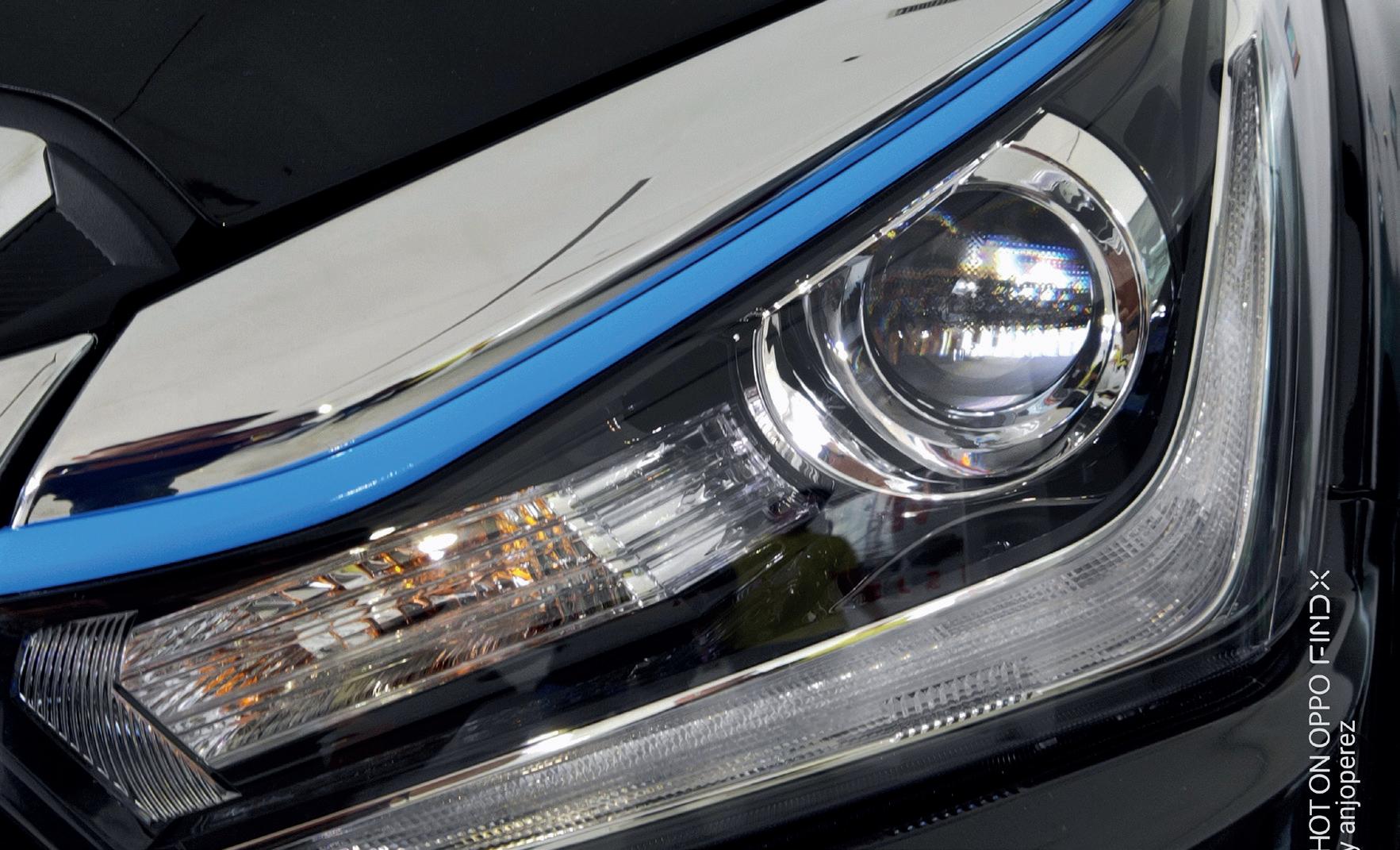




















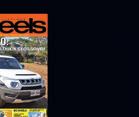









Words by Anjo Perez
s the push for ecofriendly transportation gains steam, Hybrid Electric Vehicles (HEVs) and Battery Electric Vehicles (BEVs) have emerged as key players. While fully electric vehicles promise a greener future, hybrids are proving to be the more practical option in the Philippines, where challenges like limited charging infrastructure, traffic congestion, and frequent floods prevail.
AEven Toyota, the world’s largest automaker, has opted to focus on hybrid and hydrogen technologies instead of going all-in on BEVs. Factors such as battery limitations, infrastructure issues, and the needs of local markets have shaped this strategy. Here’s why hybrids are better suited to the Philippines.
In the Philippines, where electric charging stations are few, hybrids have a clear
advantage. Unlike BEVs, which require consistent access to charging points, hybrids run on both a gasoline engine and an electric motor. This flexibility allows hybrids to be easily refueled at gas stations, offering convenience in areas with limited charging infrastructure.
The country’s urban centers, especially Metro Manila, are notorious for heavy traffic. BEVs struggle in these conditions as frequent stops drain battery life quickly. Hybrids, however, take advantage of regenerative braking, which captures energy when braking and recharges the battery. This makes hybrids more fuel-efficient and better suited for cities with constant traffic jams.
The Philippines is no stranger to floods, especially during the rainy season. BEVs, with their electric drivetrains, are vulnerable to water damage. Hybrids, with
their gasoline engines, are more reliable when navigating waterlogged streets, offering greater peace of mind in floodprone areas.
Since BEVs rely solely on battery power, they are dependent on charging stations, which can limit their range. Hybrids, by switching between electric and gasoline modes, offer greater driving distances. This is particularly useful in a country where charging infrastructure is still in its early stages, allowing hybrid drivers to travel longer distances without worrying about recharging.
While electric vehicle prices are gradually falling, hybrids remain the more affordable option. For consumers in developing markets like the Philippines, hybrids offer a greener alternative without the high costs associated with BEVs, making them a more accessible option for the average buyer.
Power outages are common in parts of the Philippines. With BEVs, drivers risk being stuck without a charged vehicle during a brownout. Hybrids, however, can switch to gasoline when electricity is unavailable, ensuring they remain functional even during power outages. This resilience makes hybrids a reliable choice for regions with unstable electricity supplies.
For many drivers, switching from gasoline-powered vehicles to fully electric cars can be overwhelming. Hybrids offer a more gradual transition, allowing drivers to experience electric driving benefits while still relying on a gasoline engine when needed. This hybrid system eases the shift towards greener transportation without the anxiety of limited range or charging access.
DFSK, a leading automotive company from Chongqing, China, has launched its latest range of energy-efficient vehicles in the Philippines. A subsidiary of the SERES Group, DFSK has been a strong player in the auto industry since 2003. Partnering with QSJ Motors since 2018, DFSK offers a variety of light trucks, commercial vehicles, and multi-purpose vehicles in the country.
With the growing demand for electric vehicles (EVs) in the Philippines, DFSK and QSJ Motors have introduced a new lineup designed to promote greener
transportation. The new models include the DFSK E5 PHEV, DFSK Candy Mini EV, and DFSK EC75 Commercial Van, each catering to different needs of Filipino drivers while encouraging an eco-friendly lifestyle.
The launch event took place on September 6, 2024, followed by a three-day exhibit at the Trinoma Activity Center in Quezon City.
DFSK E5 PHEV: A FamilyFriendly Hybrid SUV
The DFSK E5 PHEV is a 7-seater plug-in hybrid SUV. It uses a 17.52 kWh Lithium Iron Phosphate (LiFePo) battery that charges in
just four hours. Powered by a 1.5L engine and an electric motor, it delivers 130 kW of power and 300 Nm of torque. The E5 can drive up to 100 kilometers on electric power alone, with a total driving range of 1,150 kilometers.
Inside, the E5 features a panoramic sunroof, a 12.3-inch infotainment system, 12 speakers for surround sound, ventilated seats, and a dual-screen display. It also includes six airbags and advanced safety systems like hill start assist, traction control, and hill descent control.
The E5 PHEV comes in two versions: the Deluxe, priced at
P1,580,000, and the Ultimate, at P1,880,000.
DFSK Candy Mini EV: Small, Fun, and EcoFriendly
The DFSK Candy Mini EV is a cute, compact electric vehicle made for city driving. Despite being officially launched this month, it’s already been seen on Philippine roads. This small two-seater is perfect for short trips and carrying light cargo, all while being eco-friendly and easy to drive in tight spaces.
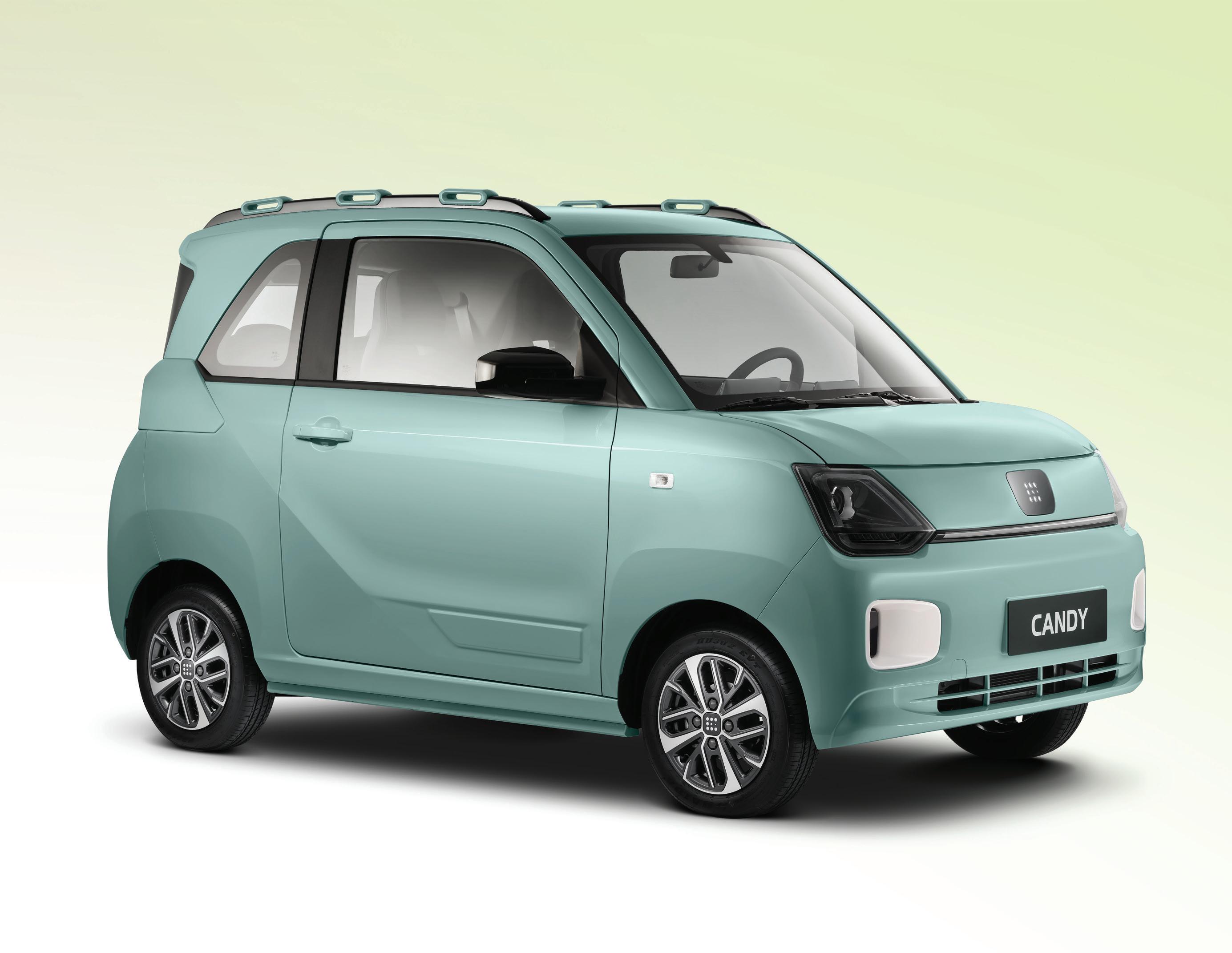
With a 30 kWh electric motor, it produces 41 PS and 100 Nm of torque, offering a range of 220 kilometers on a single charge. It can reach 50 km/h in 5.1 seconds, and its battery charges fully in 4.5 hours. Inside, it seats four people and includes a smart infotainment system, airbags, ABS with EBD, and a reverse camera.

“DFSK’s new lineup of electric and hybrid vehicles brings affordable and eco-friendly options to the Philippine market.”
The DFSK Candy Mini EV is priced at P658,000.
For businesses wanting to go electric, the DFSK EC75 E-Negosyo Van is an ideal choice. With seating for two passengers and 7 cubic meters of cargo space, it’s perfect for deliveries and logistics. Its durable design makes it suitable for heavy-duty tasks.
Powered by a single electric motor, the van generates 95 PS and 230 Nm of torque, with a range of 310 kilometers. Its 50.38 kWh battery can be fast-charged in 45 minutes. The van also includes wireless phone charging, real-time tracking, and fleet management systems, making it convenient for business use.
The DFSK EC75 E-Negosyo Van is available for P1,450,000.
DFSK’s new lineup of electric and hybrid vehicles brings affordable and eco-friendly options to the Philippine market. Whether you’re looking for a family SUV like the DFSK E5 PHEV, a fun and compact city car like the DFSK Candy Mini EV, or a business van like the DFSK EC75, DFSK is helping Filipinos embrace the future of green transportation.
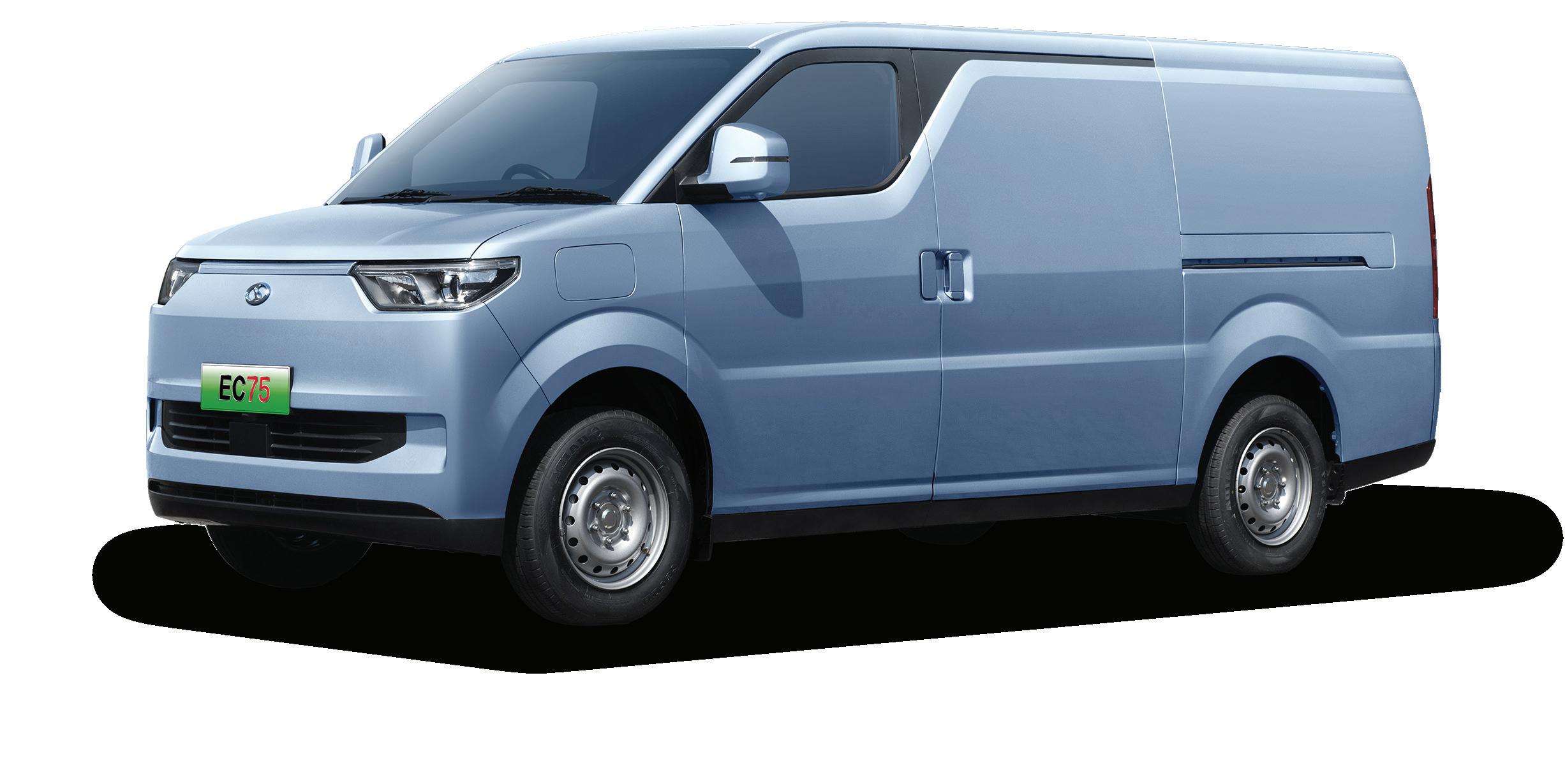

The Nissan Patrol has always been a top choice in the fullsize SUV market, standing alongside the Toyota Land Cruiser in strength and reputation. After more than 10 years, Nissan has finally revealed the much-awaited 2025 Nissan Patrol—the seventh generation of this legendary SUV. With its mix of modern design, luxury, and off-road power, the Patrol is entering a new phase that sets even higher standards.
The 2025 Nissan Patrol keeps the core features that have made it popular for years but now has a more modern and stylish design. At the front, bold LED headlights are connected by a light bar, giving it a strong and striking look. The unique C-shaped LED daytime running lights, along with adaptive technology, combine style with function. The SUV’s
sides have a sharper look, and the option for a black roof adds a sleek touch. The back also mirrors the front with fullwidth LED taillights, making the design balanced from all angles.
Inside, the new Patrol takes comfort and technology to another level. The standout feature is the huge 28.6-inch “Monolith” display, made of two 14.3-inch screens. It runs on the latest NissanConnect 2.0 system, which now includes Google services, making it easy to use Google apps. You also get wireless Apple CarPlay and Android Auto for seamless smartphone connectivity.
For sound, Nissan has added a 12-speaker Klipsch surround system that gives you a rich, concert-like audio experience. Luxury touches like quilted leather seats and unique Japanese
woodcraft designs make the cabin feel special. Depending on where you buy it, you can also get extras like massaging front seats and LED mood lighting with 64 color options.
Nissan has also added a new feature called Biometric Cooling, which uses sensors to check the temperature of passengers in the front and second rows, adjusting the airflow to keep everyone comfortable. The second-row passengers also have optional 12.8-inch touchscreens to keep them entertained on long trips.
The 2025 Patrol continues to offer lots of space, especially in the second and third rows, perfect for families and larger groups. The EZ Flex seating system makes it easy to access the third row without removing a child seat. The third row can also fold down with the touch
of a button, giving you flexible storage options, all controlled through the Monolith display.
Under the hood, Nissan has made a big change by switching from the older 5.6-liter V8 engine to a more efficient 3.5-liter twin-turbo V6. Don’t let the smaller size fool you—this V6 produces 425 horsepower and 700 Nm of torque, which is 25 horsepower more than the old V8. Power goes to all four wheels through a new nine-speed automatic transmission, offering smooth driving on highways and excellent performance off-road.
The ride quality is also improved with new e-damper technology, which adjusts to different road conditions in real-time. Whether you’re driving through the city or tackling rough terrain, the Patrol promises a comfortable and controlled ride.
Safety is a top priority with the 2025 Patrol, thanks to Nissan’s ProPILOT system, part of the Nissan Intelligent Mobility package. ProPILOT helps

with adaptive cruise control and lanecentering, even using navigation to assist during curves and highway merges. The SUV is also easier to park and maneuver with its Ultra-Wide 360-degree camera and Invisible Hood View, which give a clear view of the surroundings.
The 2025 Nissan Patrol made its first appearance in Dubai and will launch

in the Middle East before hitting global markets. In the Philippines, where the Patrol has a strong following, expect to see it arrive by mid-2025.
The 2025 Nissan Patrol isn’t just another new model—it’s a bold upgrade of an already beloved SUV, now packed with features and technologies that prepare it for the future.

Following its successful brand launch at the Manila International Auto Show (MIAS) last April, JAC Philippines recently held its first media event, showcasing the all-new JS6 compact SUV and JS8 PRO mid-size SUV. As part of Astara Philippines’ lineup, JAC offers affordable options across a diverse range of vehicles,
including electric vehicles, pickups, and SUVs.
The event, held at JAC’s newly opened dealership, introduced key models and highlighted the brand’s plans for growth, including the expansion of its network to six dealerships, with more to come. By the end of the year, JAC aims to introduce seven new models tailored to


different customer needs, from subcompact SUVs to pickups and electric vehicles.
The drive event, which started and ended at JAC Manila Bay along Macapagal Avenue in Pasay City, gave media participants the opportunity to experience the new SUVs firsthand.
The JS8 PRO, a 7-seater midsize SUV, provides 418 liters of cargo space, expandable to 2,153 liters when the third-row seats are folded. This makes it ideal for both daily drives and family trips. The SUV also features an electric tailgate for easy loading, a panoramic sunroof, and dual 12.3-inch digital screens, including a touchscreen infotainment system with Apple CarPlay, Android Auto, and a 360-degree panoramic camera.
Additional features include power-adjustable front seats, wireless charging, and independent climate control for front and rear passengers. Safety systems include Blind Spot Detection, Lane Change
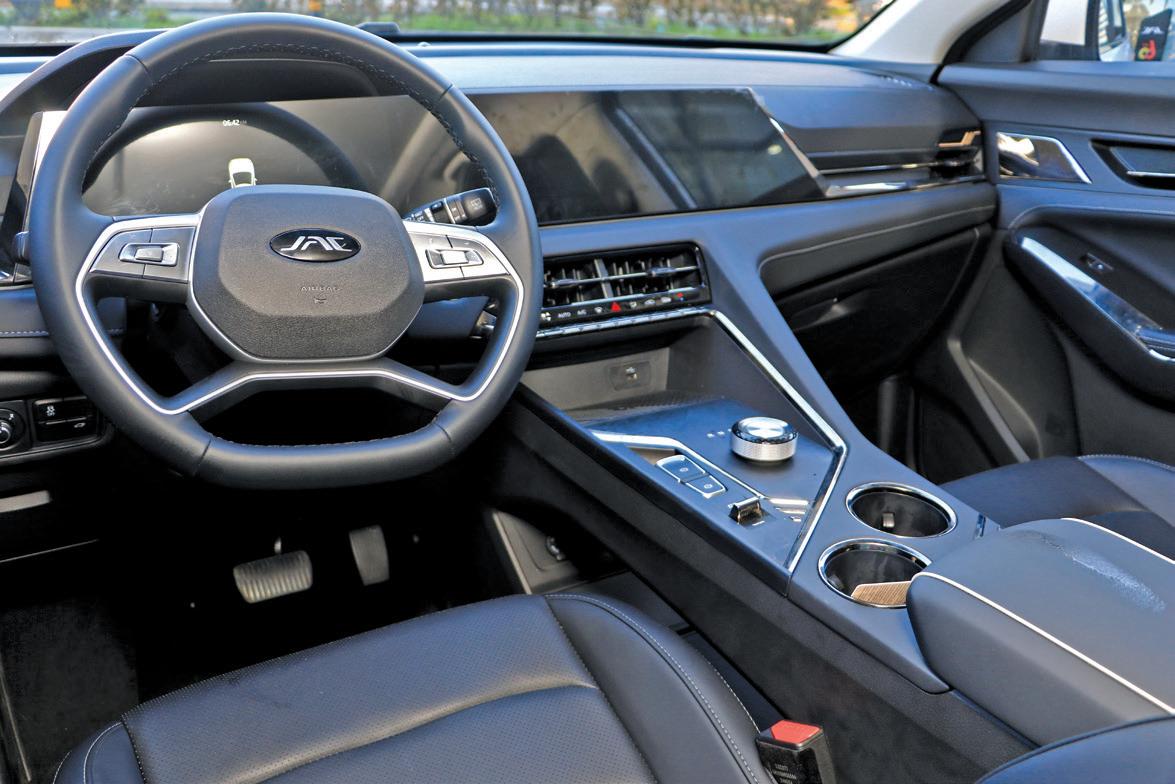
Assist, Door Opening Warning, and multiple airbags, alongside ISOFIX child seat anchors.
The JS8 PRO is powered by a 1.5-liter turbocharged engine paired with a 7-speed dualclutch transmission. It is priced at P1,350,000 and is available in Pearl White, Carmenere Red, and Stylish Black.
The JS6 compact SUV is equipped with a 1.5-liter turbocharged engine and a 6-speed dual-clutch
transmission, delivering 182 horsepower and 300 Nm of torque. It offers a 160-mm ground clearance and favorable approach and departure angles for city and off-road driving. The SUV also includes power-folding side mirrors, a panoramic sunroof, and an electric tailgate.
Inside, the JS6 features two 12.3-inch displays, leather seats, wireless charging, dual-zone climate control, and a 360-degree camera. The rear seats have a 60:40 split-fold option for added versatility. Safety features include six airbags, ISOFIX anchors, and an Electronic Stability Program,
along with advanced driver assistance systems such as Automatic Emergency Braking, Lane Departure Warning, and Blind Spot Monitoring.
The JS6 is priced at P1,380,000 and is available in five colors: Pearl White, Carmenere Red, Moonstone Blue, Stylish Black, and Obsidian Grey.
Both the JS8 PRO and JS6 come with a 5-year warranty or 150,000 kilometers, whichever comes first. Buyers also receive 24/7 Emergency Roadside Assistance for the first year.
JAC’s new models offer a range of features at competitive prices, providing more options in the local SUV market. Both the JS8 PRO and JS6 are now available at JAC dealerships nationwide.



United Asia Automotive Group Inc. (UAAGI) has just introduced its most affordable hybrid off-roader yet—the BAIC B30e Dune. With a starting price of P1,488,000, this hybrid electric vehicle (HEV) is designed to cater to both city drivers and adventure seekers looking to hit the trails.
The BAIC B30e Dune comes in two versions: a 4x2 model with a single electric motor and a 4x4 option powered by dual electric motors. Both versions are equipped with a 1.5-liter turbocharged power generator and a Dedicated Hybrid Transmission. The vehicle’s Smart Hybrid System, with its six energy management modes, ensures efficient use of power whether you’re on the highway or tackling rough terrain. In terms of performance,
the 4x2 model offers a solid 329 horsepower and 550 Nm of torque, while the 4x4 kicks things up a notch with 403 horsepower and 685 Nm of torque. The B30e Dune isn’t just about strength; it’s quick, too, with a 0 to 100 km/h acceleration time of just 6.9 seconds.
Off-road enthusiasts will appreciate the 4x4 version’s Real-Time Intelligent 4-Wheel Drive system, complemented by a 7-mode All Terrain System, which allows drivers to switch between modes like Comfort, Sport, Economy, Snow, Sand, Mud, and even Wading. With 215mm of ground clearance and 19-inch alloy wheels, this hybrid is built to handle whatever nature throws at it. Its approach and departure angles, along with a wading depth of 450mm, make it an ideal companion for off-road adventures.
The B30e Dune isn’t just tough on the outside; it’s also luxurious on the inside. With a 2,820mm wheelbase, the cabin offers plenty of space for both passengers and gear. The interior features heated and airconditioned front seats, a sleek 10.25-inch digital instrument panel, and a 14.6-inch floating central display. There’s also a cargo bed that stretches to 1.9 meters, providing 1,496 liters of storage space—perfect for camping trips or weekend getaways.
For those who love the outdoors, the B30e Dune includes a smartly designed trunk picnic table that’s stored behind the second-row seats. Measuring 110cm by 30.2cm, this foldable table is perfect for roadside meals or impromptu picnics in nature.
Safety hasn’t been overlooked
either. The B30e Dune comes loaded with a Level 2 Advanced Driver Assist System (ADAS), offering features like Cruise Control, Blind Spot Monitoring, Lane Assist, Autonomous Emergency Braking, and a 360-degree around-view monitor. Parking is made easier with reverse cameras and sensors as standard.
On top of all that, the B30e Dune boasts premium touches like leather seats, a panoramic sunroof, rain-sensing wipers, a smart power tailgate, adaptive cruise control, and full-LED lighting.
Available at BAIC showrooms, the B30e Dune is ready to hit both the city streets and the toughest off-road trails. It joins a lineup that includes the X55 Verve, X7 Grandeza, B40 Ragnar, B60 Beaumont, and B80 Wagon.
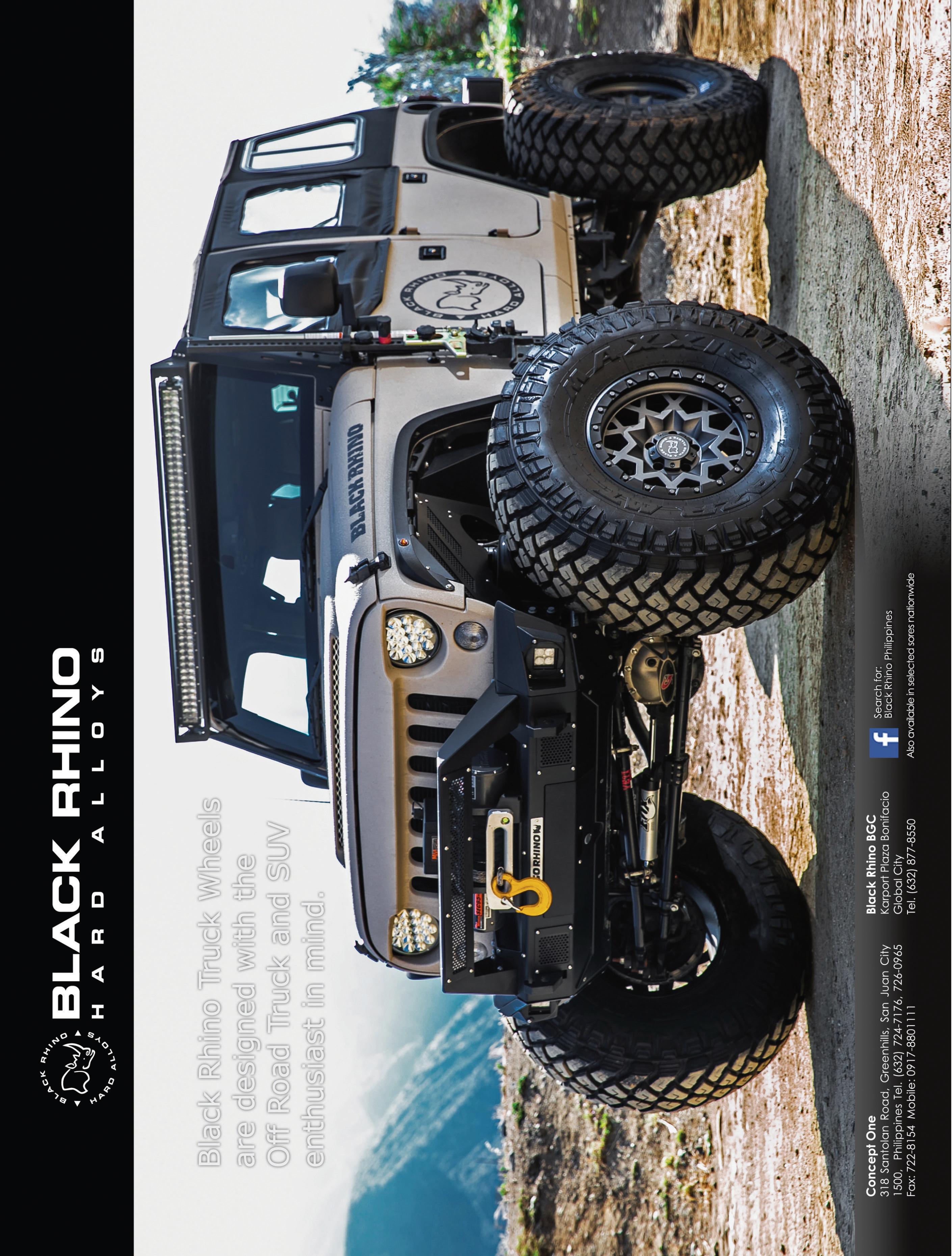
HYBRID CARS VS. EVS: THE SMART CHOICE FOR THE PHILIPPINES A MAGAZINE ON BIKES, VANS, TRUCKS AND SUVS
